Mining Industry in Australia: Analysis and Challenges
VerifiedAdded on 2020/03/23
|21
|4853
|28
AI Summary
This assignment delves into the multifaceted aspects of the Australian mining industry. It examines the efficiency performance of major mining companies through data envelopment analysis. Further, it explores regional development issues, the intersection of mining with water resources and human rights, and the social license to operate in the sector. The assignment also considers the strategic challenges faced by the industry, including climate change accounting and its impact on corporate disclosure and legitimacy. Finally, it analyzes the economic conditions shaping the industry's landscape.
Contribute Materials
Your contribution can guide someone’s learning journey. Share your
documents today.
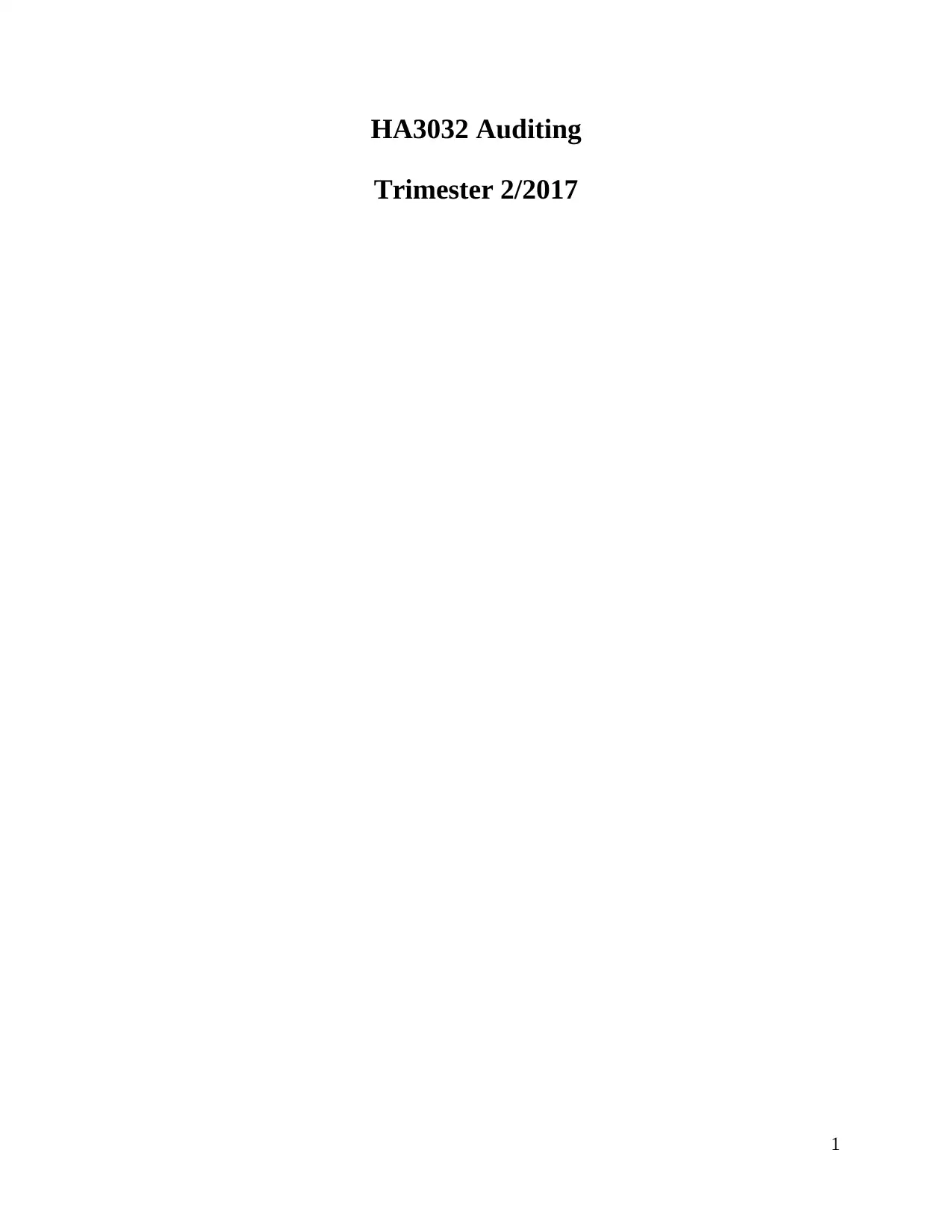
HA3032 Auditing
Trimester 2/2017
1
Trimester 2/2017
1
Secure Best Marks with AI Grader
Need help grading? Try our AI Grader for instant feedback on your assignments.
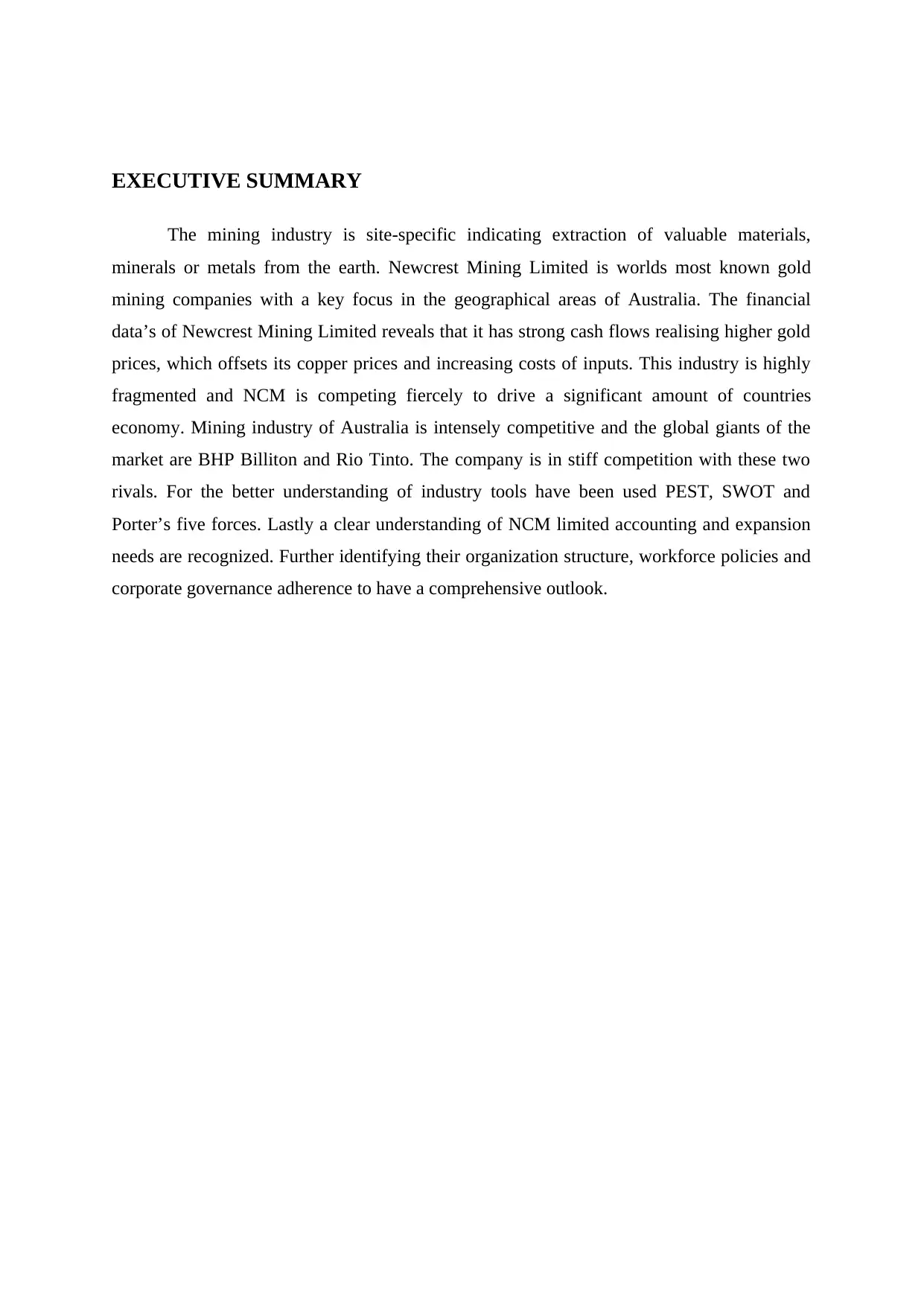
EXECUTIVE SUMMARY
The mining industry is site-specific indicating extraction of valuable materials,
minerals or metals from the earth. Newcrest Mining Limited is worlds most known gold
mining companies with a key focus in the geographical areas of Australia. The financial
data’s of Newcrest Mining Limited reveals that it has strong cash flows realising higher gold
prices, which offsets its copper prices and increasing costs of inputs. This industry is highly
fragmented and NCM is competing fiercely to drive a significant amount of countries
economy. Mining industry of Australia is intensely competitive and the global giants of the
market are BHP Billiton and Rio Tinto. The company is in stiff competition with these two
rivals. For the better understanding of industry tools have been used PEST, SWOT and
Porter’s five forces. Lastly a clear understanding of NCM limited accounting and expansion
needs are recognized. Further identifying their organization structure, workforce policies and
corporate governance adherence to have a comprehensive outlook.
The mining industry is site-specific indicating extraction of valuable materials,
minerals or metals from the earth. Newcrest Mining Limited is worlds most known gold
mining companies with a key focus in the geographical areas of Australia. The financial
data’s of Newcrest Mining Limited reveals that it has strong cash flows realising higher gold
prices, which offsets its copper prices and increasing costs of inputs. This industry is highly
fragmented and NCM is competing fiercely to drive a significant amount of countries
economy. Mining industry of Australia is intensely competitive and the global giants of the
market are BHP Billiton and Rio Tinto. The company is in stiff competition with these two
rivals. For the better understanding of industry tools have been used PEST, SWOT and
Porter’s five forces. Lastly a clear understanding of NCM limited accounting and expansion
needs are recognized. Further identifying their organization structure, workforce policies and
corporate governance adherence to have a comprehensive outlook.
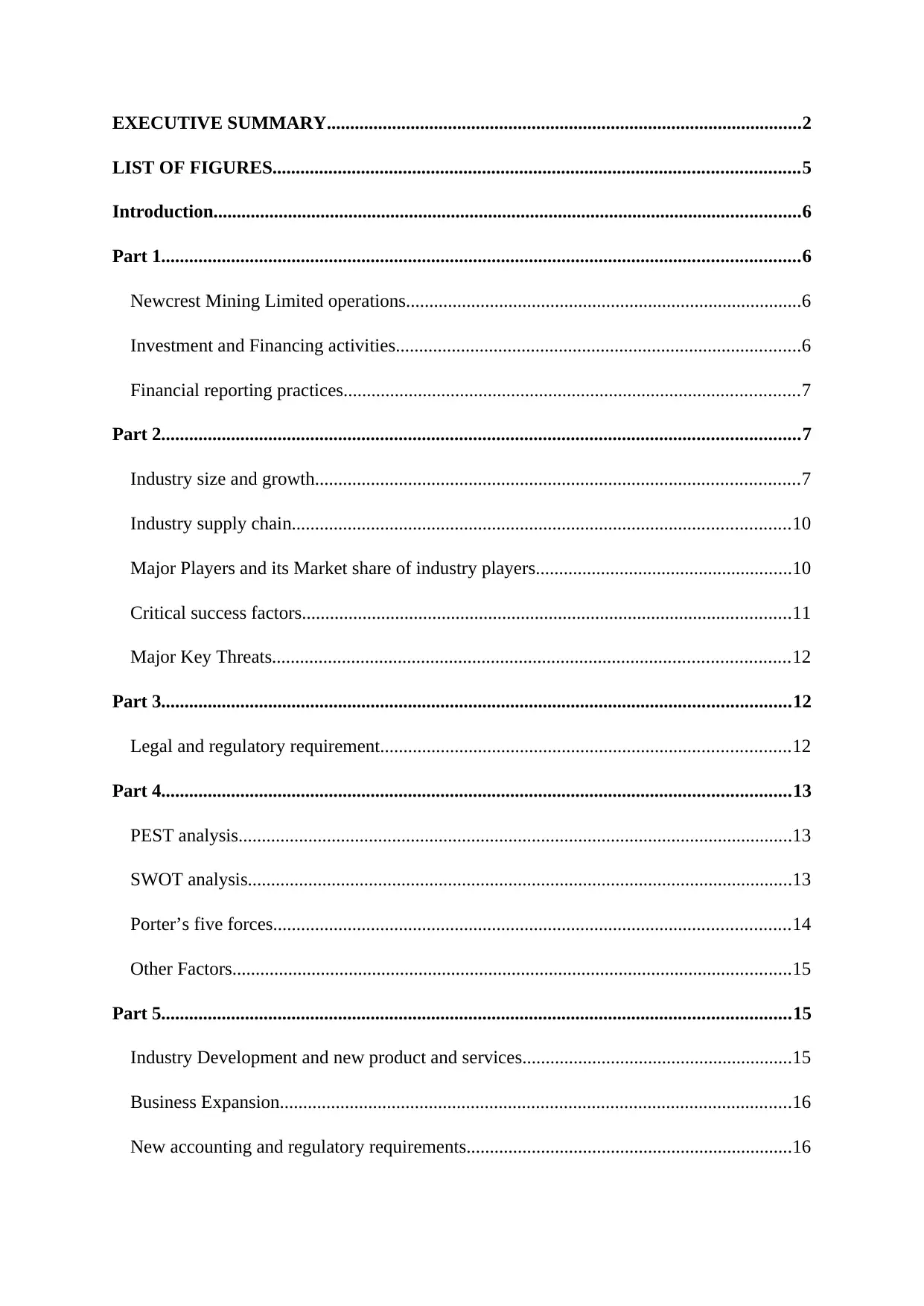
EXECUTIVE SUMMARY......................................................................................................2
LIST OF FIGURES.................................................................................................................5
Introduction..............................................................................................................................6
Part 1.........................................................................................................................................6
Newcrest Mining Limited operations.....................................................................................6
Investment and Financing activities.......................................................................................6
Financial reporting practices..................................................................................................7
Part 2.........................................................................................................................................7
Industry size and growth........................................................................................................7
Industry supply chain...........................................................................................................10
Major Players and its Market share of industry players.......................................................10
Critical success factors.........................................................................................................11
Major Key Threats...............................................................................................................12
Part 3.......................................................................................................................................12
Legal and regulatory requirement........................................................................................12
Part 4.......................................................................................................................................13
PEST analysis.......................................................................................................................13
SWOT analysis.....................................................................................................................13
Porter’s five forces...............................................................................................................14
Other Factors........................................................................................................................15
Part 5.......................................................................................................................................15
Industry Development and new product and services..........................................................15
Business Expansion..............................................................................................................16
New accounting and regulatory requirements......................................................................16
LIST OF FIGURES.................................................................................................................5
Introduction..............................................................................................................................6
Part 1.........................................................................................................................................6
Newcrest Mining Limited operations.....................................................................................6
Investment and Financing activities.......................................................................................6
Financial reporting practices..................................................................................................7
Part 2.........................................................................................................................................7
Industry size and growth........................................................................................................7
Industry supply chain...........................................................................................................10
Major Players and its Market share of industry players.......................................................10
Critical success factors.........................................................................................................11
Major Key Threats...............................................................................................................12
Part 3.......................................................................................................................................12
Legal and regulatory requirement........................................................................................12
Part 4.......................................................................................................................................13
PEST analysis.......................................................................................................................13
SWOT analysis.....................................................................................................................13
Porter’s five forces...............................................................................................................14
Other Factors........................................................................................................................15
Part 5.......................................................................................................................................15
Industry Development and new product and services..........................................................15
Business Expansion..............................................................................................................16
New accounting and regulatory requirements......................................................................16
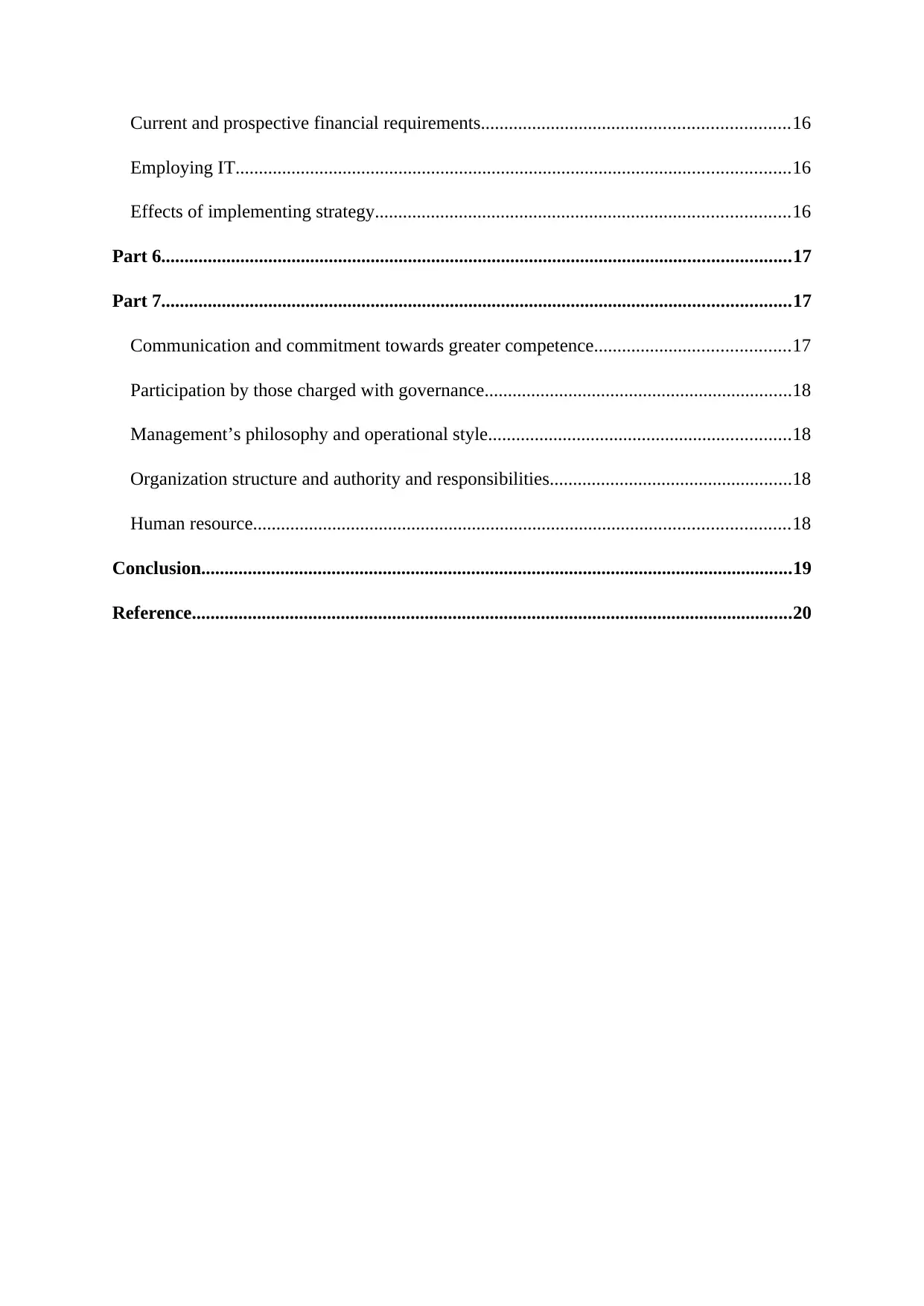
Current and prospective financial requirements..................................................................16
Employing IT.......................................................................................................................16
Effects of implementing strategy.........................................................................................16
Part 6.......................................................................................................................................17
Part 7.......................................................................................................................................17
Communication and commitment towards greater competence..........................................17
Participation by those charged with governance..................................................................18
Management’s philosophy and operational style.................................................................18
Organization structure and authority and responsibilities....................................................18
Human resource...................................................................................................................18
Conclusion...............................................................................................................................19
Reference.................................................................................................................................20
Employing IT.......................................................................................................................16
Effects of implementing strategy.........................................................................................16
Part 6.......................................................................................................................................17
Part 7.......................................................................................................................................17
Communication and commitment towards greater competence..........................................17
Participation by those charged with governance..................................................................18
Management’s philosophy and operational style.................................................................18
Organization structure and authority and responsibilities....................................................18
Human resource...................................................................................................................18
Conclusion...............................................................................................................................19
Reference.................................................................................................................................20
Secure Best Marks with AI Grader
Need help grading? Try our AI Grader for instant feedback on your assignments.
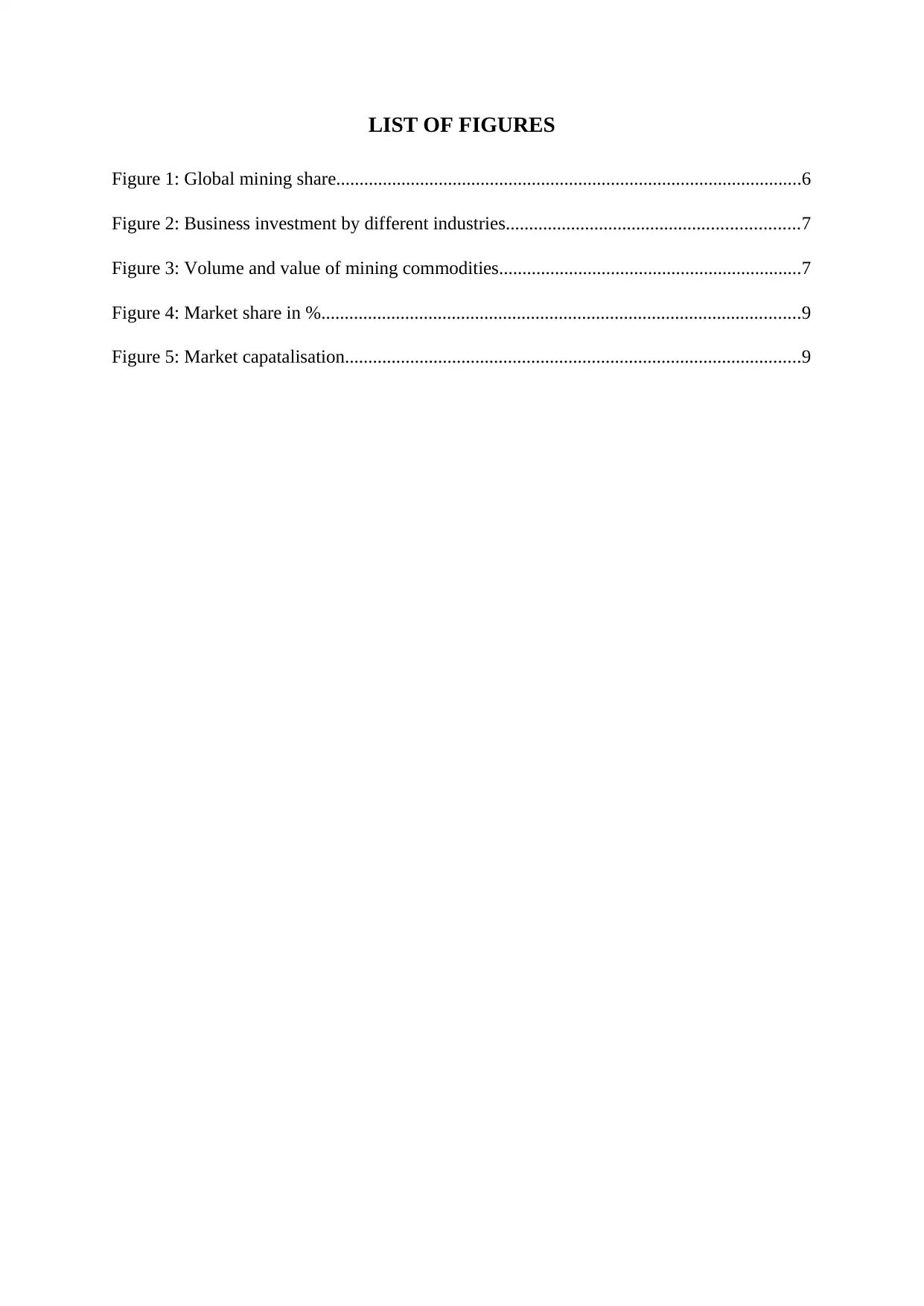
LIST OF FIGURES
Figure 1: Global mining share....................................................................................................6
Figure 2: Business investment by different industries...............................................................7
Figure 3: Volume and value of mining commodities.................................................................7
Figure 4: Market share in %.......................................................................................................9
Figure 5: Market capatalisation..................................................................................................9
Figure 1: Global mining share....................................................................................................6
Figure 2: Business investment by different industries...............................................................7
Figure 3: Volume and value of mining commodities.................................................................7
Figure 4: Market share in %.......................................................................................................9
Figure 5: Market capatalisation..................................................................................................9
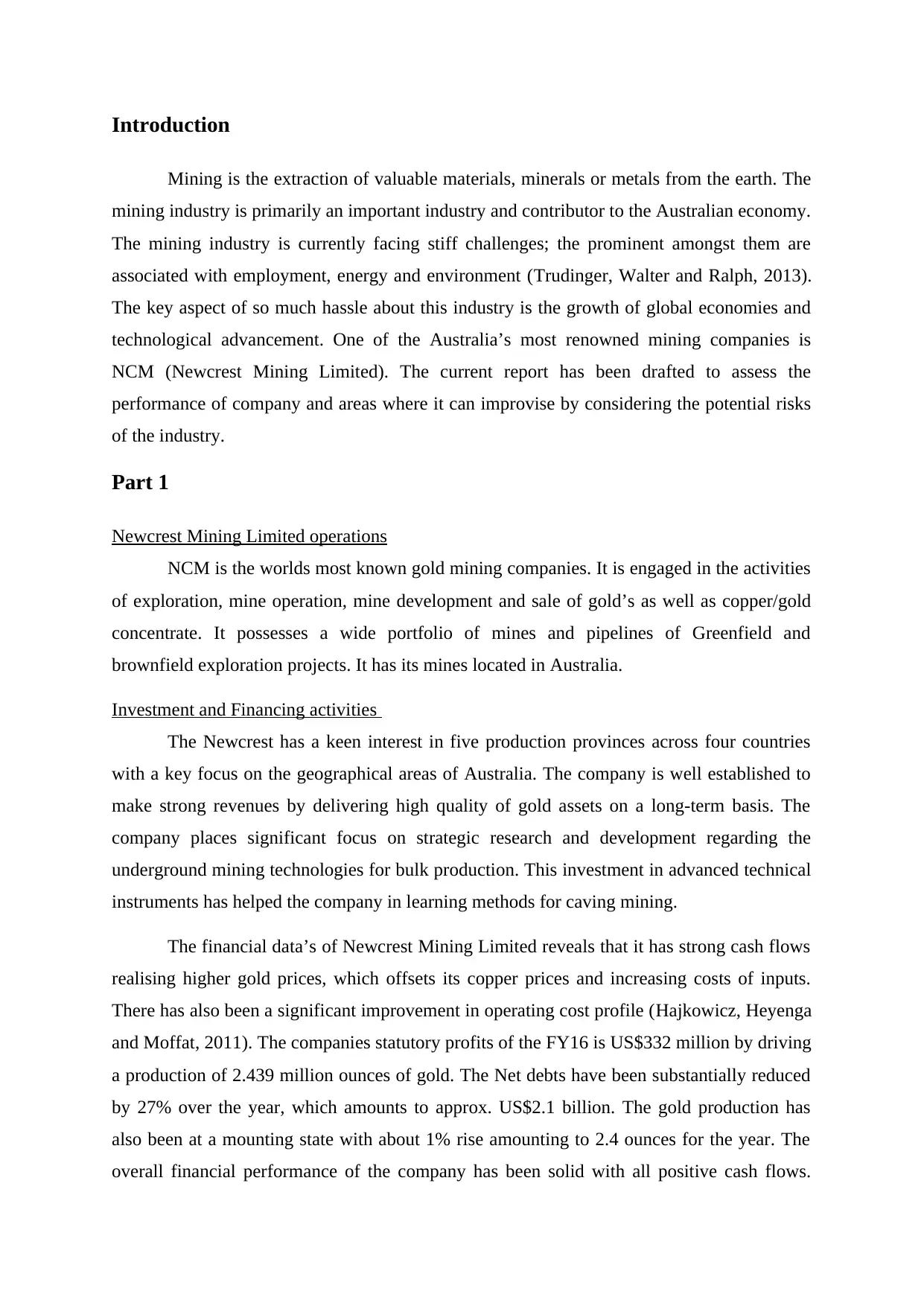
Introduction
Mining is the extraction of valuable materials, minerals or metals from the earth. The
mining industry is primarily an important industry and contributor to the Australian economy.
The mining industry is currently facing stiff challenges; the prominent amongst them are
associated with employment, energy and environment (Trudinger, Walter and Ralph, 2013).
The key aspect of so much hassle about this industry is the growth of global economies and
technological advancement. One of the Australia’s most renowned mining companies is
NCM (Newcrest Mining Limited). The current report has been drafted to assess the
performance of company and areas where it can improvise by considering the potential risks
of the industry.
Part 1
Newcrest Mining Limited operations
NCM is the worlds most known gold mining companies. It is engaged in the activities
of exploration, mine operation, mine development and sale of gold’s as well as copper/gold
concentrate. It possesses a wide portfolio of mines and pipelines of Greenfield and
brownfield exploration projects. It has its mines located in Australia.
Investment and Financing activities
The Newcrest has a keen interest in five production provinces across four countries
with a key focus on the geographical areas of Australia. The company is well established to
make strong revenues by delivering high quality of gold assets on a long-term basis. The
company places significant focus on strategic research and development regarding the
underground mining technologies for bulk production. This investment in advanced technical
instruments has helped the company in learning methods for caving mining.
The financial data’s of Newcrest Mining Limited reveals that it has strong cash flows
realising higher gold prices, which offsets its copper prices and increasing costs of inputs.
There has also been a significant improvement in operating cost profile (Hajkowicz, Heyenga
and Moffat, 2011). The companies statutory profits of the FY16 is US$332 million by driving
a production of 2.439 million ounces of gold. The Net debts have been substantially reduced
by 27% over the year, which amounts to approx. US$2.1 billion. The gold production has
also been at a mounting state with about 1% rise amounting to 2.4 ounces for the year. The
overall financial performance of the company has been solid with all positive cash flows.
Mining is the extraction of valuable materials, minerals or metals from the earth. The
mining industry is primarily an important industry and contributor to the Australian economy.
The mining industry is currently facing stiff challenges; the prominent amongst them are
associated with employment, energy and environment (Trudinger, Walter and Ralph, 2013).
The key aspect of so much hassle about this industry is the growth of global economies and
technological advancement. One of the Australia’s most renowned mining companies is
NCM (Newcrest Mining Limited). The current report has been drafted to assess the
performance of company and areas where it can improvise by considering the potential risks
of the industry.
Part 1
Newcrest Mining Limited operations
NCM is the worlds most known gold mining companies. It is engaged in the activities
of exploration, mine operation, mine development and sale of gold’s as well as copper/gold
concentrate. It possesses a wide portfolio of mines and pipelines of Greenfield and
brownfield exploration projects. It has its mines located in Australia.
Investment and Financing activities
The Newcrest has a keen interest in five production provinces across four countries
with a key focus on the geographical areas of Australia. The company is well established to
make strong revenues by delivering high quality of gold assets on a long-term basis. The
company places significant focus on strategic research and development regarding the
underground mining technologies for bulk production. This investment in advanced technical
instruments has helped the company in learning methods for caving mining.
The financial data’s of Newcrest Mining Limited reveals that it has strong cash flows
realising higher gold prices, which offsets its copper prices and increasing costs of inputs.
There has also been a significant improvement in operating cost profile (Hajkowicz, Heyenga
and Moffat, 2011). The companies statutory profits of the FY16 is US$332 million by driving
a production of 2.439 million ounces of gold. The Net debts have been substantially reduced
by 27% over the year, which amounts to approx. US$2.1 billion. The gold production has
also been at a mounting state with about 1% rise amounting to 2.4 ounces for the year. The
overall financial performance of the company has been solid with all positive cash flows.
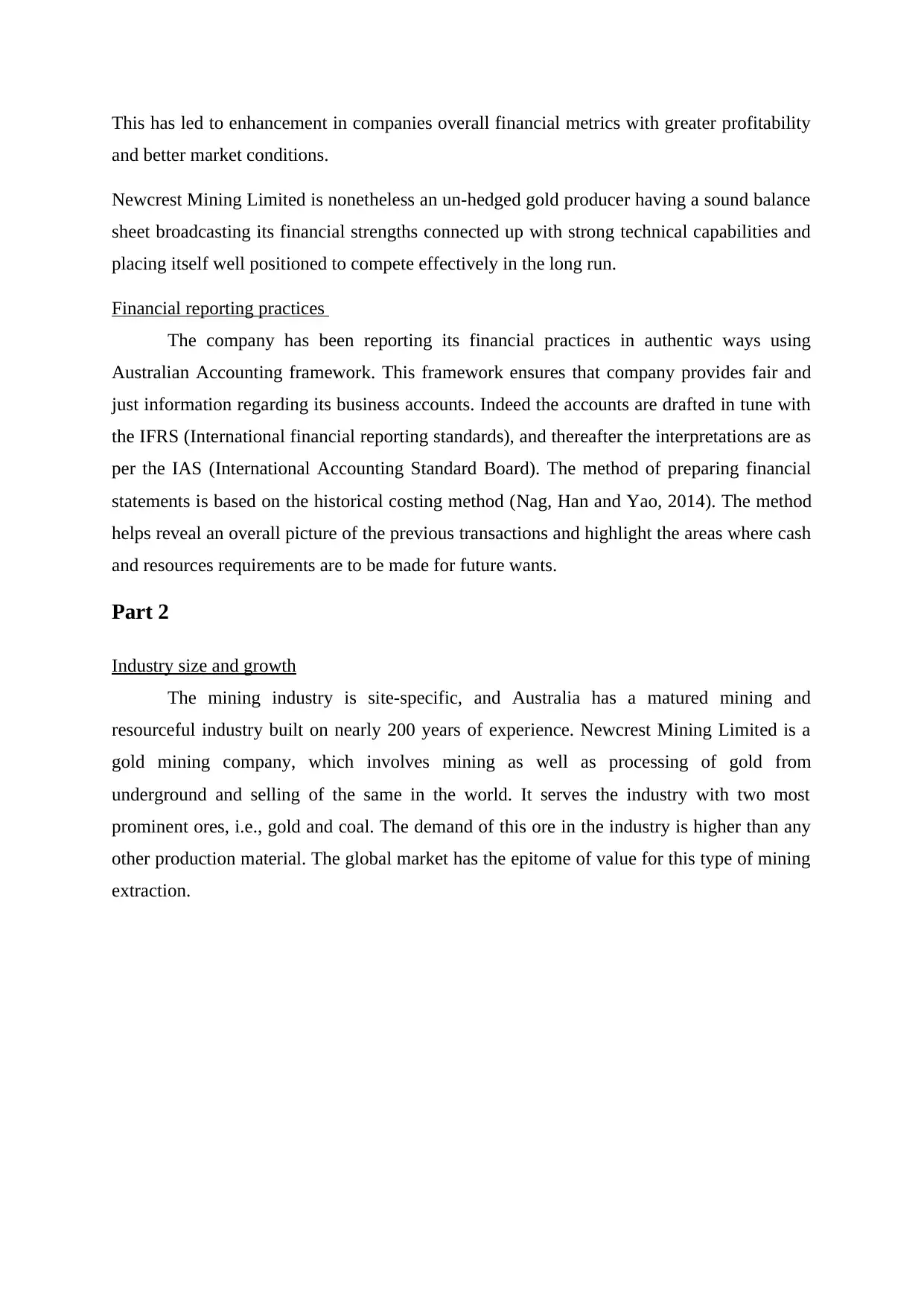
This has led to enhancement in companies overall financial metrics with greater profitability
and better market conditions.
Newcrest Mining Limited is nonetheless an un-hedged gold producer having a sound balance
sheet broadcasting its financial strengths connected up with strong technical capabilities and
placing itself well positioned to compete effectively in the long run.
Financial reporting practices
The company has been reporting its financial practices in authentic ways using
Australian Accounting framework. This framework ensures that company provides fair and
just information regarding its business accounts. Indeed the accounts are drafted in tune with
the IFRS (International financial reporting standards), and thereafter the interpretations are as
per the IAS (International Accounting Standard Board). The method of preparing financial
statements is based on the historical costing method (Nag, Han and Yao, 2014). The method
helps reveal an overall picture of the previous transactions and highlight the areas where cash
and resources requirements are to be made for future wants.
Part 2
Industry size and growth
The mining industry is site-specific, and Australia has a matured mining and
resourceful industry built on nearly 200 years of experience. Newcrest Mining Limited is a
gold mining company, which involves mining as well as processing of gold from
underground and selling of the same in the world. It serves the industry with two most
prominent ores, i.e., gold and coal. The demand of this ore in the industry is higher than any
other production material. The global market has the epitome of value for this type of mining
extraction.
and better market conditions.
Newcrest Mining Limited is nonetheless an un-hedged gold producer having a sound balance
sheet broadcasting its financial strengths connected up with strong technical capabilities and
placing itself well positioned to compete effectively in the long run.
Financial reporting practices
The company has been reporting its financial practices in authentic ways using
Australian Accounting framework. This framework ensures that company provides fair and
just information regarding its business accounts. Indeed the accounts are drafted in tune with
the IFRS (International financial reporting standards), and thereafter the interpretations are as
per the IAS (International Accounting Standard Board). The method of preparing financial
statements is based on the historical costing method (Nag, Han and Yao, 2014). The method
helps reveal an overall picture of the previous transactions and highlight the areas where cash
and resources requirements are to be made for future wants.
Part 2
Industry size and growth
The mining industry is site-specific, and Australia has a matured mining and
resourceful industry built on nearly 200 years of experience. Newcrest Mining Limited is a
gold mining company, which involves mining as well as processing of gold from
underground and selling of the same in the world. It serves the industry with two most
prominent ores, i.e., gold and coal. The demand of this ore in the industry is higher than any
other production material. The global market has the epitome of value for this type of mining
extraction.
Paraphrase This Document
Need a fresh take? Get an instant paraphrase of this document with our AI Paraphraser
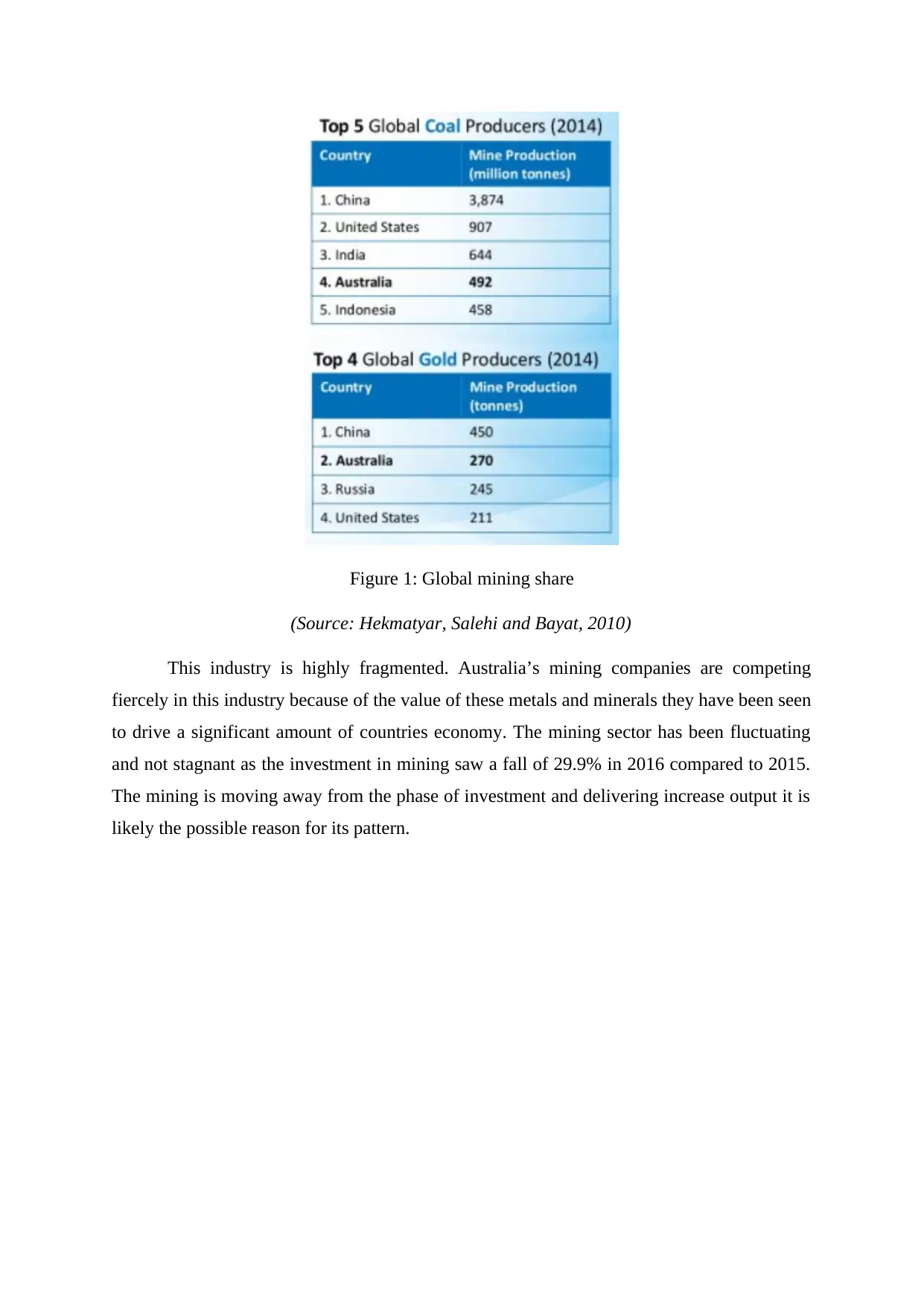
Figure 1: Global mining share
(Source: Hekmatyar, Salehi and Bayat, 2010)
This industry is highly fragmented. Australia’s mining companies are competing
fiercely in this industry because of the value of these metals and minerals they have been seen
to drive a significant amount of countries economy. The mining sector has been fluctuating
and not stagnant as the investment in mining saw a fall of 29.9% in 2016 compared to 2015.
The mining is moving away from the phase of investment and delivering increase output it is
likely the possible reason for its pattern.
(Source: Hekmatyar, Salehi and Bayat, 2010)
This industry is highly fragmented. Australia’s mining companies are competing
fiercely in this industry because of the value of these metals and minerals they have been seen
to drive a significant amount of countries economy. The mining sector has been fluctuating
and not stagnant as the investment in mining saw a fall of 29.9% in 2016 compared to 2015.
The mining is moving away from the phase of investment and delivering increase output it is
likely the possible reason for its pattern.
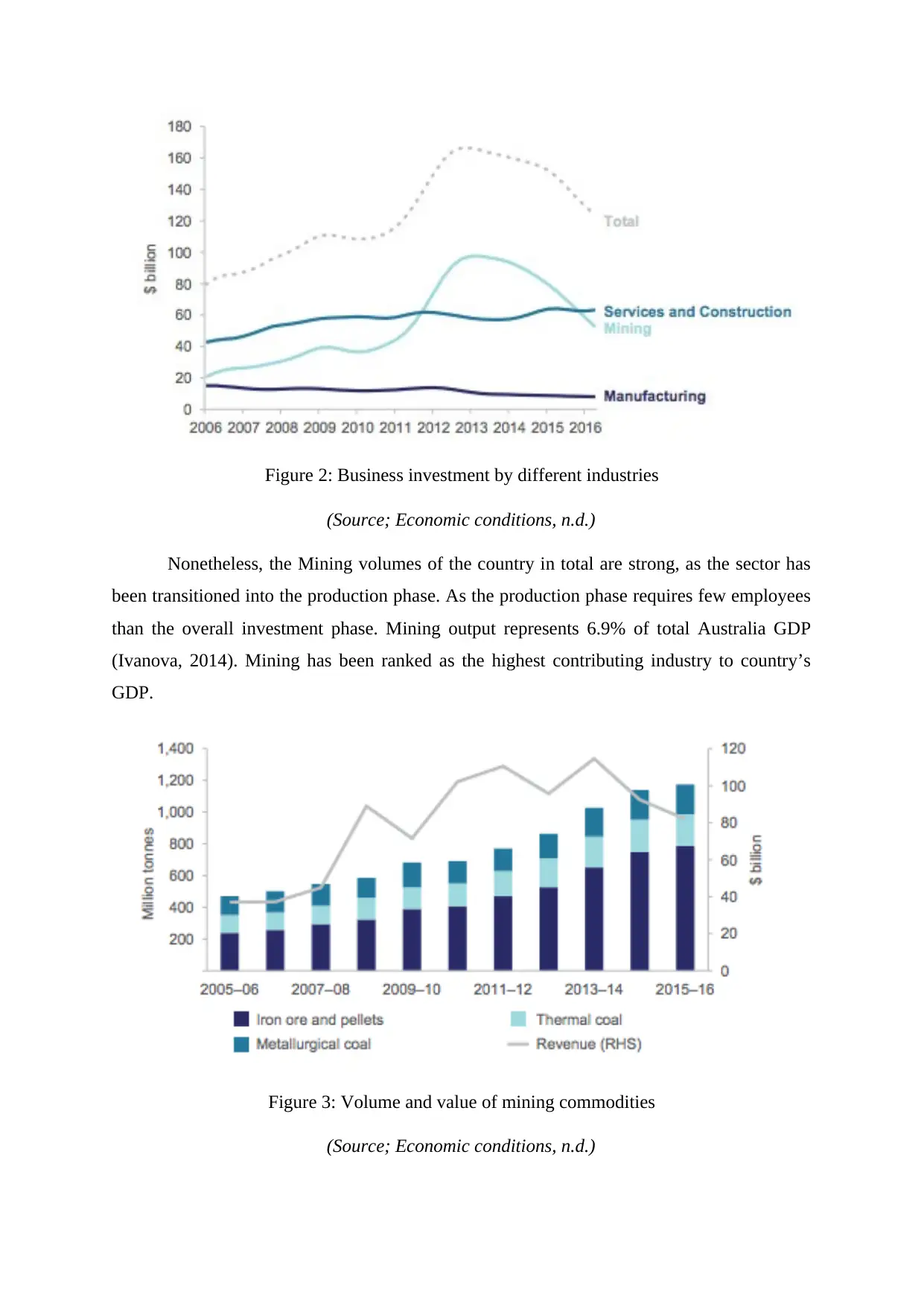
Figure 2: Business investment by different industries
(Source; Economic conditions, n.d.)
Nonetheless, the Mining volumes of the country in total are strong, as the sector has
been transitioned into the production phase. As the production phase requires few employees
than the overall investment phase. Mining output represents 6.9% of total Australia GDP
(Ivanova, 2014). Mining has been ranked as the highest contributing industry to country’s
GDP.
Figure 3: Volume and value of mining commodities
(Source; Economic conditions, n.d.)
(Source; Economic conditions, n.d.)
Nonetheless, the Mining volumes of the country in total are strong, as the sector has
been transitioned into the production phase. As the production phase requires few employees
than the overall investment phase. Mining output represents 6.9% of total Australia GDP
(Ivanova, 2014). Mining has been ranked as the highest contributing industry to country’s
GDP.
Figure 3: Volume and value of mining commodities
(Source; Economic conditions, n.d.)
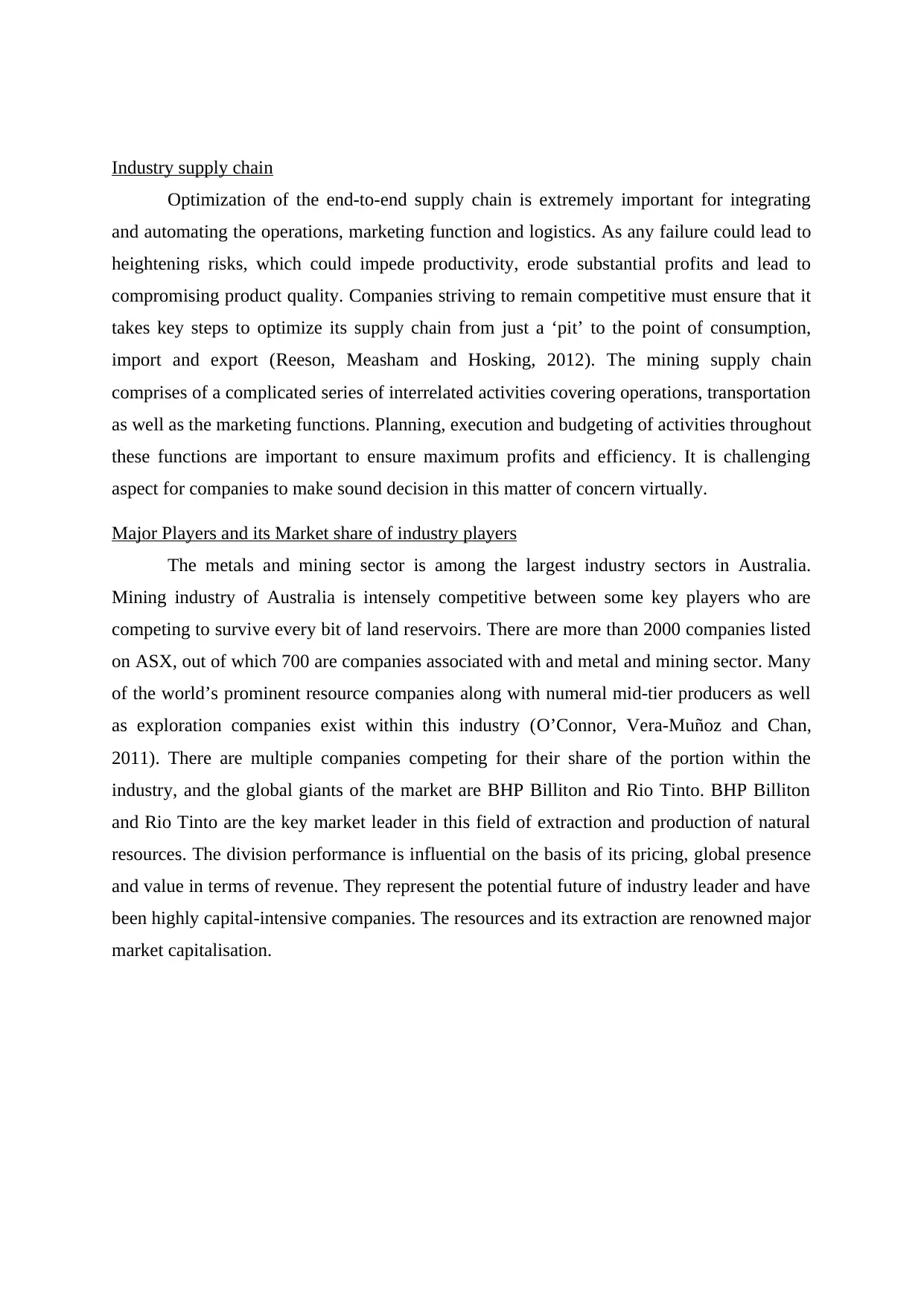
Industry supply chain
Optimization of the end-to-end supply chain is extremely important for integrating
and automating the operations, marketing function and logistics. As any failure could lead to
heightening risks, which could impede productivity, erode substantial profits and lead to
compromising product quality. Companies striving to remain competitive must ensure that it
takes key steps to optimize its supply chain from just a ‘pit’ to the point of consumption,
import and export (Reeson, Measham and Hosking, 2012). The mining supply chain
comprises of a complicated series of interrelated activities covering operations, transportation
as well as the marketing functions. Planning, execution and budgeting of activities throughout
these functions are important to ensure maximum profits and efficiency. It is challenging
aspect for companies to make sound decision in this matter of concern virtually.
Major Players and its Market share of industry players
The metals and mining sector is among the largest industry sectors in Australia.
Mining industry of Australia is intensely competitive between some key players who are
competing to survive every bit of land reservoirs. There are more than 2000 companies listed
on ASX, out of which 700 are companies associated with and metal and mining sector. Many
of the world’s prominent resource companies along with numeral mid-tier producers as well
as exploration companies exist within this industry (O’Connor, Vera-Muñoz and Chan,
2011). There are multiple companies competing for their share of the portion within the
industry, and the global giants of the market are BHP Billiton and Rio Tinto. BHP Billiton
and Rio Tinto are the key market leader in this field of extraction and production of natural
resources. The division performance is influential on the basis of its pricing, global presence
and value in terms of revenue. They represent the potential future of industry leader and have
been highly capital-intensive companies. The resources and its extraction are renowned major
market capitalisation.
Optimization of the end-to-end supply chain is extremely important for integrating
and automating the operations, marketing function and logistics. As any failure could lead to
heightening risks, which could impede productivity, erode substantial profits and lead to
compromising product quality. Companies striving to remain competitive must ensure that it
takes key steps to optimize its supply chain from just a ‘pit’ to the point of consumption,
import and export (Reeson, Measham and Hosking, 2012). The mining supply chain
comprises of a complicated series of interrelated activities covering operations, transportation
as well as the marketing functions. Planning, execution and budgeting of activities throughout
these functions are important to ensure maximum profits and efficiency. It is challenging
aspect for companies to make sound decision in this matter of concern virtually.
Major Players and its Market share of industry players
The metals and mining sector is among the largest industry sectors in Australia.
Mining industry of Australia is intensely competitive between some key players who are
competing to survive every bit of land reservoirs. There are more than 2000 companies listed
on ASX, out of which 700 are companies associated with and metal and mining sector. Many
of the world’s prominent resource companies along with numeral mid-tier producers as well
as exploration companies exist within this industry (O’Connor, Vera-Muñoz and Chan,
2011). There are multiple companies competing for their share of the portion within the
industry, and the global giants of the market are BHP Billiton and Rio Tinto. BHP Billiton
and Rio Tinto are the key market leader in this field of extraction and production of natural
resources. The division performance is influential on the basis of its pricing, global presence
and value in terms of revenue. They represent the potential future of industry leader and have
been highly capital-intensive companies. The resources and its extraction are renowned major
market capitalisation.
Secure Best Marks with AI Grader
Need help grading? Try our AI Grader for instant feedback on your assignments.
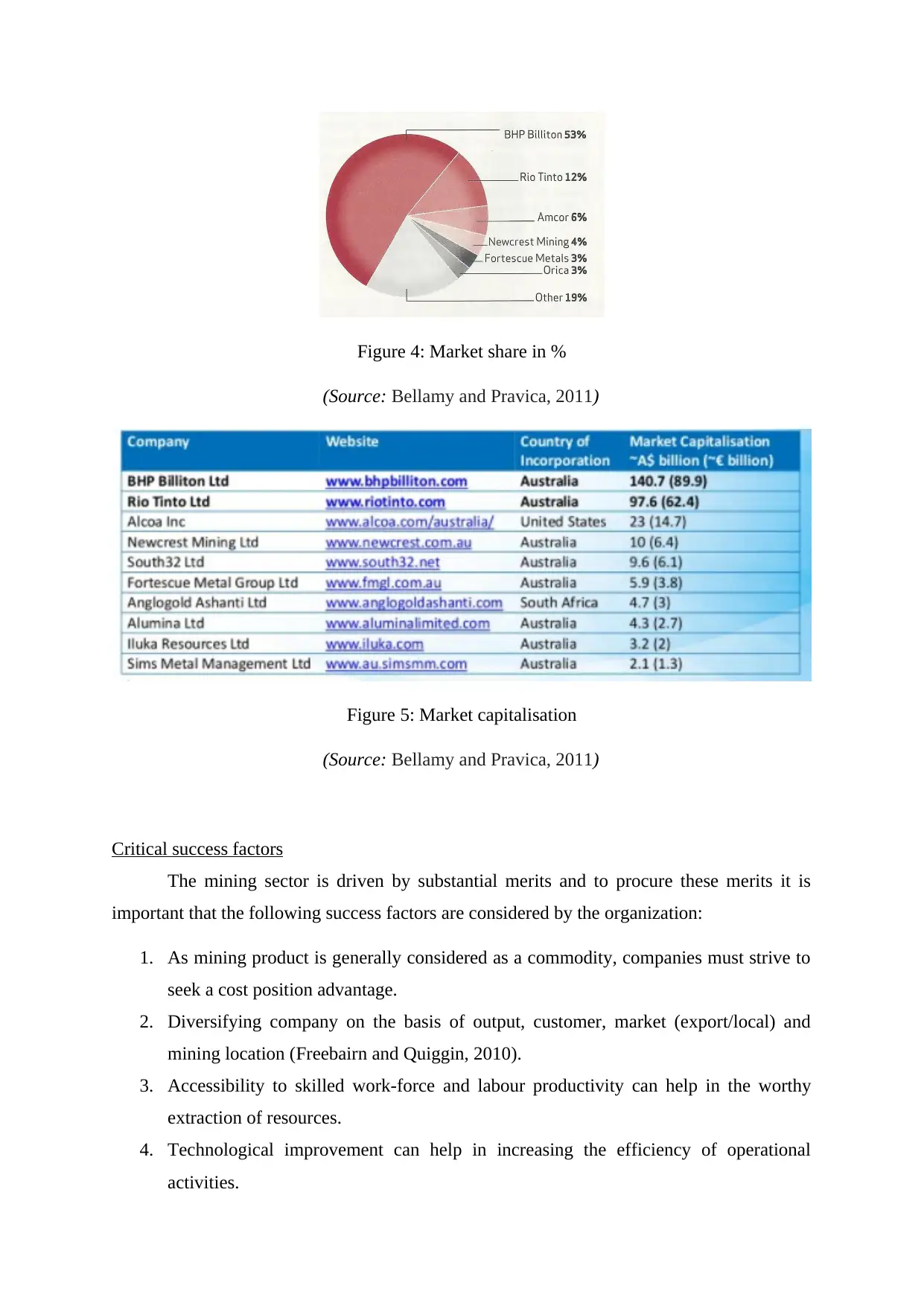
Figure 4: Market share in %
(Source: Bellamy and Pravica, 2011)
Figure 5: Market capitalisation
(Source: Bellamy and Pravica, 2011)
Critical success factors
The mining sector is driven by substantial merits and to procure these merits it is
important that the following success factors are considered by the organization:
1. As mining product is generally considered as a commodity, companies must strive to
seek a cost position advantage.
2. Diversifying company on the basis of output, customer, market (export/local) and
mining location (Freebairn and Quiggin, 2010).
3. Accessibility to skilled work-force and labour productivity can help in the worthy
extraction of resources.
4. Technological improvement can help in increasing the efficiency of operational
activities.
(Source: Bellamy and Pravica, 2011)
Figure 5: Market capitalisation
(Source: Bellamy and Pravica, 2011)
Critical success factors
The mining sector is driven by substantial merits and to procure these merits it is
important that the following success factors are considered by the organization:
1. As mining product is generally considered as a commodity, companies must strive to
seek a cost position advantage.
2. Diversifying company on the basis of output, customer, market (export/local) and
mining location (Freebairn and Quiggin, 2010).
3. Accessibility to skilled work-force and labour productivity can help in the worthy
extraction of resources.
4. Technological improvement can help in increasing the efficiency of operational
activities.
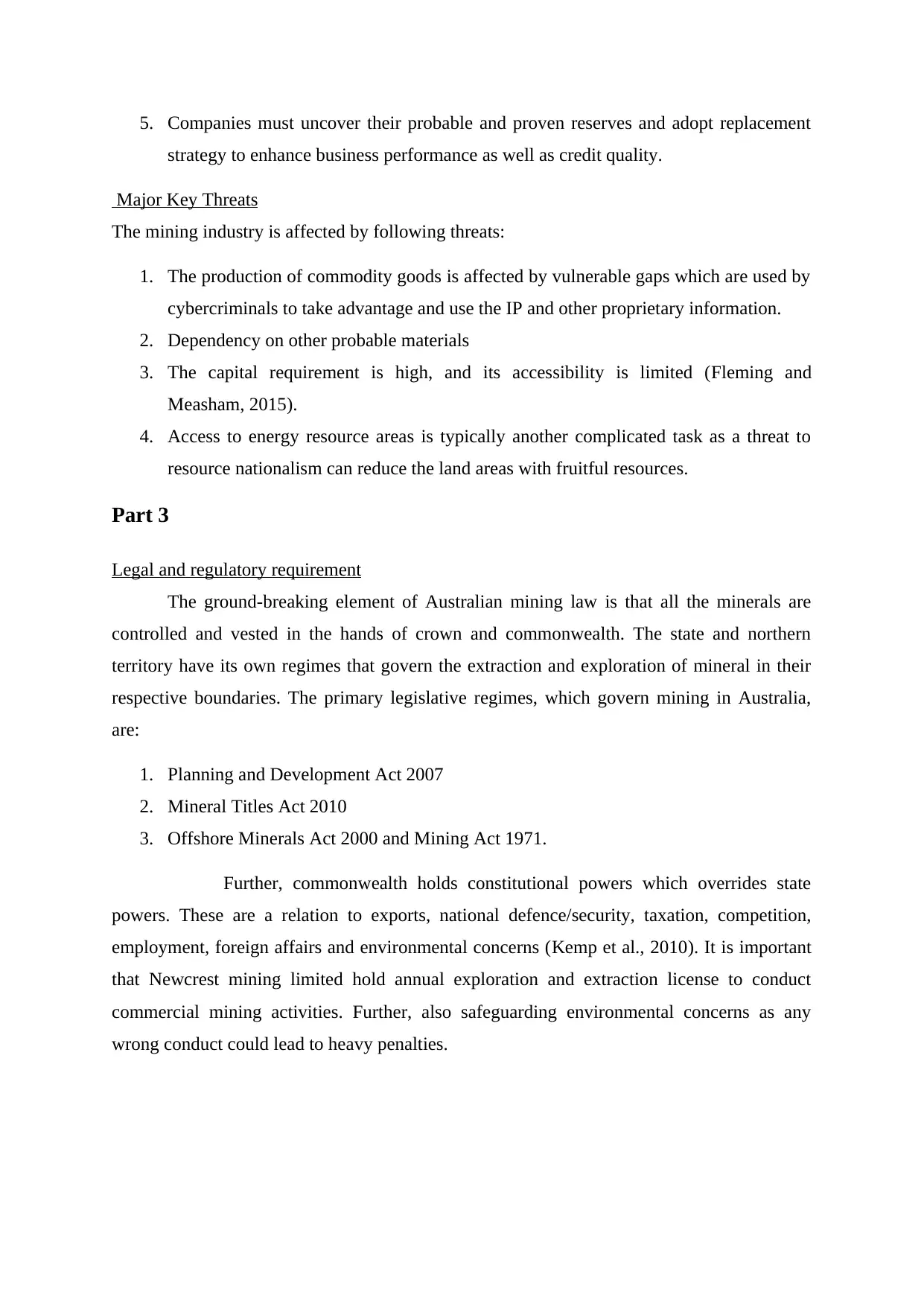
5. Companies must uncover their probable and proven reserves and adopt replacement
strategy to enhance business performance as well as credit quality.
Major Key Threats
The mining industry is affected by following threats:
1. The production of commodity goods is affected by vulnerable gaps which are used by
cybercriminals to take advantage and use the IP and other proprietary information.
2. Dependency on other probable materials
3. The capital requirement is high, and its accessibility is limited (Fleming and
Measham, 2015).
4. Access to energy resource areas is typically another complicated task as a threat to
resource nationalism can reduce the land areas with fruitful resources.
Part 3
Legal and regulatory requirement
The ground-breaking element of Australian mining law is that all the minerals are
controlled and vested in the hands of crown and commonwealth. The state and northern
territory have its own regimes that govern the extraction and exploration of mineral in their
respective boundaries. The primary legislative regimes, which govern mining in Australia,
are:
1. Planning and Development Act 2007
2. Mineral Titles Act 2010
3. Offshore Minerals Act 2000 and Mining Act 1971.
Further, commonwealth holds constitutional powers which overrides state
powers. These are a relation to exports, national defence/security, taxation, competition,
employment, foreign affairs and environmental concerns (Kemp et al., 2010). It is important
that Newcrest mining limited hold annual exploration and extraction license to conduct
commercial mining activities. Further, also safeguarding environmental concerns as any
wrong conduct could lead to heavy penalties.
strategy to enhance business performance as well as credit quality.
Major Key Threats
The mining industry is affected by following threats:
1. The production of commodity goods is affected by vulnerable gaps which are used by
cybercriminals to take advantage and use the IP and other proprietary information.
2. Dependency on other probable materials
3. The capital requirement is high, and its accessibility is limited (Fleming and
Measham, 2015).
4. Access to energy resource areas is typically another complicated task as a threat to
resource nationalism can reduce the land areas with fruitful resources.
Part 3
Legal and regulatory requirement
The ground-breaking element of Australian mining law is that all the minerals are
controlled and vested in the hands of crown and commonwealth. The state and northern
territory have its own regimes that govern the extraction and exploration of mineral in their
respective boundaries. The primary legislative regimes, which govern mining in Australia,
are:
1. Planning and Development Act 2007
2. Mineral Titles Act 2010
3. Offshore Minerals Act 2000 and Mining Act 1971.
Further, commonwealth holds constitutional powers which overrides state
powers. These are a relation to exports, national defence/security, taxation, competition,
employment, foreign affairs and environmental concerns (Kemp et al., 2010). It is important
that Newcrest mining limited hold annual exploration and extraction license to conduct
commercial mining activities. Further, also safeguarding environmental concerns as any
wrong conduct could lead to heavy penalties.
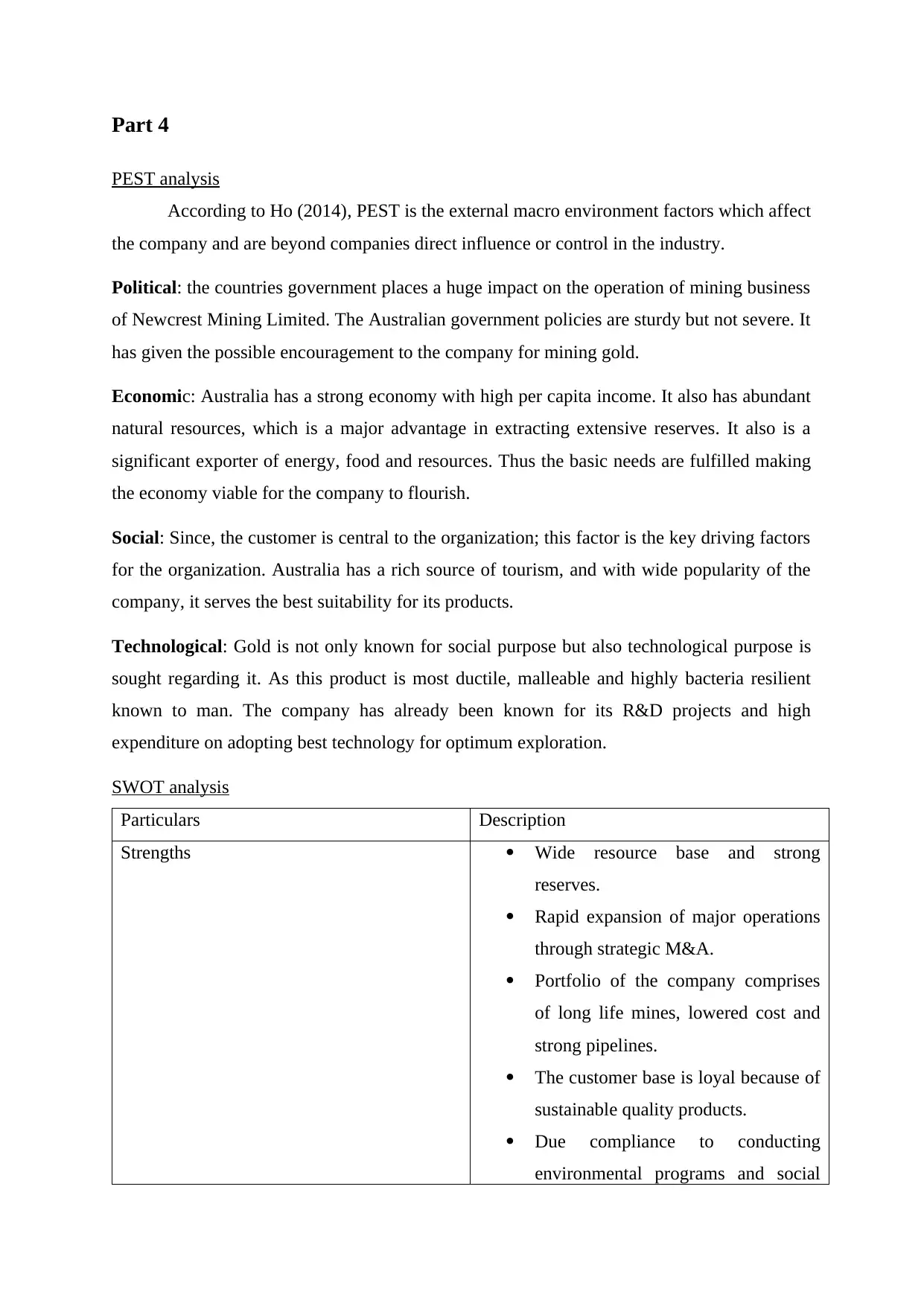
Part 4
PEST analysis
According to Ho (2014), PEST is the external macro environment factors which affect
the company and are beyond companies direct influence or control in the industry.
Political: the countries government places a huge impact on the operation of mining business
of Newcrest Mining Limited. The Australian government policies are sturdy but not severe. It
has given the possible encouragement to the company for mining gold.
Economic: Australia has a strong economy with high per capita income. It also has abundant
natural resources, which is a major advantage in extracting extensive reserves. It also is a
significant exporter of energy, food and resources. Thus the basic needs are fulfilled making
the economy viable for the company to flourish.
Social: Since, the customer is central to the organization; this factor is the key driving factors
for the organization. Australia has a rich source of tourism, and with wide popularity of the
company, it serves the best suitability for its products.
Technological: Gold is not only known for social purpose but also technological purpose is
sought regarding it. As this product is most ductile, malleable and highly bacteria resilient
known to man. The company has already been known for its R&D projects and high
expenditure on adopting best technology for optimum exploration.
SWOT analysis
Particulars Description
Strengths Wide resource base and strong
reserves.
Rapid expansion of major operations
through strategic M&A.
Portfolio of the company comprises
of long life mines, lowered cost and
strong pipelines.
The customer base is loyal because of
sustainable quality products.
Due compliance to conducting
environmental programs and social
PEST analysis
According to Ho (2014), PEST is the external macro environment factors which affect
the company and are beyond companies direct influence or control in the industry.
Political: the countries government places a huge impact on the operation of mining business
of Newcrest Mining Limited. The Australian government policies are sturdy but not severe. It
has given the possible encouragement to the company for mining gold.
Economic: Australia has a strong economy with high per capita income. It also has abundant
natural resources, which is a major advantage in extracting extensive reserves. It also is a
significant exporter of energy, food and resources. Thus the basic needs are fulfilled making
the economy viable for the company to flourish.
Social: Since, the customer is central to the organization; this factor is the key driving factors
for the organization. Australia has a rich source of tourism, and with wide popularity of the
company, it serves the best suitability for its products.
Technological: Gold is not only known for social purpose but also technological purpose is
sought regarding it. As this product is most ductile, malleable and highly bacteria resilient
known to man. The company has already been known for its R&D projects and high
expenditure on adopting best technology for optimum exploration.
SWOT analysis
Particulars Description
Strengths Wide resource base and strong
reserves.
Rapid expansion of major operations
through strategic M&A.
Portfolio of the company comprises
of long life mines, lowered cost and
strong pipelines.
The customer base is loyal because of
sustainable quality products.
Due compliance to conducting
environmental programs and social
Paraphrase This Document
Need a fresh take? Get an instant paraphrase of this document with our AI Paraphraser
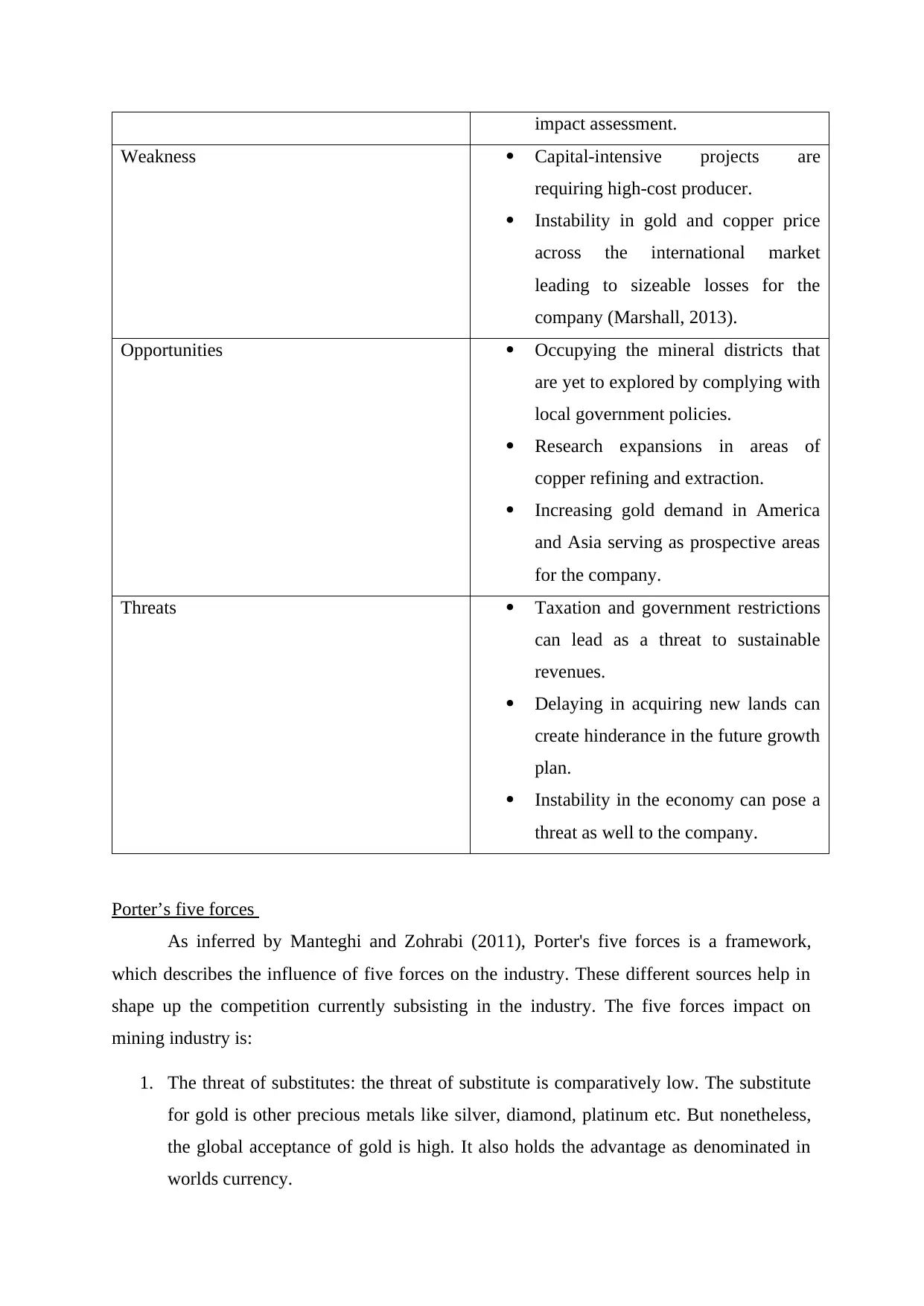
impact assessment.
Weakness Capital-intensive projects are
requiring high-cost producer.
Instability in gold and copper price
across the international market
leading to sizeable losses for the
company (Marshall, 2013).
Opportunities Occupying the mineral districts that
are yet to explored by complying with
local government policies.
Research expansions in areas of
copper refining and extraction.
Increasing gold demand in America
and Asia serving as prospective areas
for the company.
Threats Taxation and government restrictions
can lead as a threat to sustainable
revenues.
Delaying in acquiring new lands can
create hinderance in the future growth
plan.
Instability in the economy can pose a
threat as well to the company.
Porter’s five forces
As inferred by Manteghi and Zohrabi (2011), Porter's five forces is a framework,
which describes the influence of five forces on the industry. These different sources help in
shape up the competition currently subsisting in the industry. The five forces impact on
mining industry is:
1. The threat of substitutes: the threat of substitute is comparatively low. The substitute
for gold is other precious metals like silver, diamond, platinum etc. But nonetheless,
the global acceptance of gold is high. It also holds the advantage as denominated in
worlds currency.
Weakness Capital-intensive projects are
requiring high-cost producer.
Instability in gold and copper price
across the international market
leading to sizeable losses for the
company (Marshall, 2013).
Opportunities Occupying the mineral districts that
are yet to explored by complying with
local government policies.
Research expansions in areas of
copper refining and extraction.
Increasing gold demand in America
and Asia serving as prospective areas
for the company.
Threats Taxation and government restrictions
can lead as a threat to sustainable
revenues.
Delaying in acquiring new lands can
create hinderance in the future growth
plan.
Instability in the economy can pose a
threat as well to the company.
Porter’s five forces
As inferred by Manteghi and Zohrabi (2011), Porter's five forces is a framework,
which describes the influence of five forces on the industry. These different sources help in
shape up the competition currently subsisting in the industry. The five forces impact on
mining industry is:
1. The threat of substitutes: the threat of substitute is comparatively low. The substitute
for gold is other precious metals like silver, diamond, platinum etc. But nonetheless,
the global acceptance of gold is high. It also holds the advantage as denominated in
worlds currency.
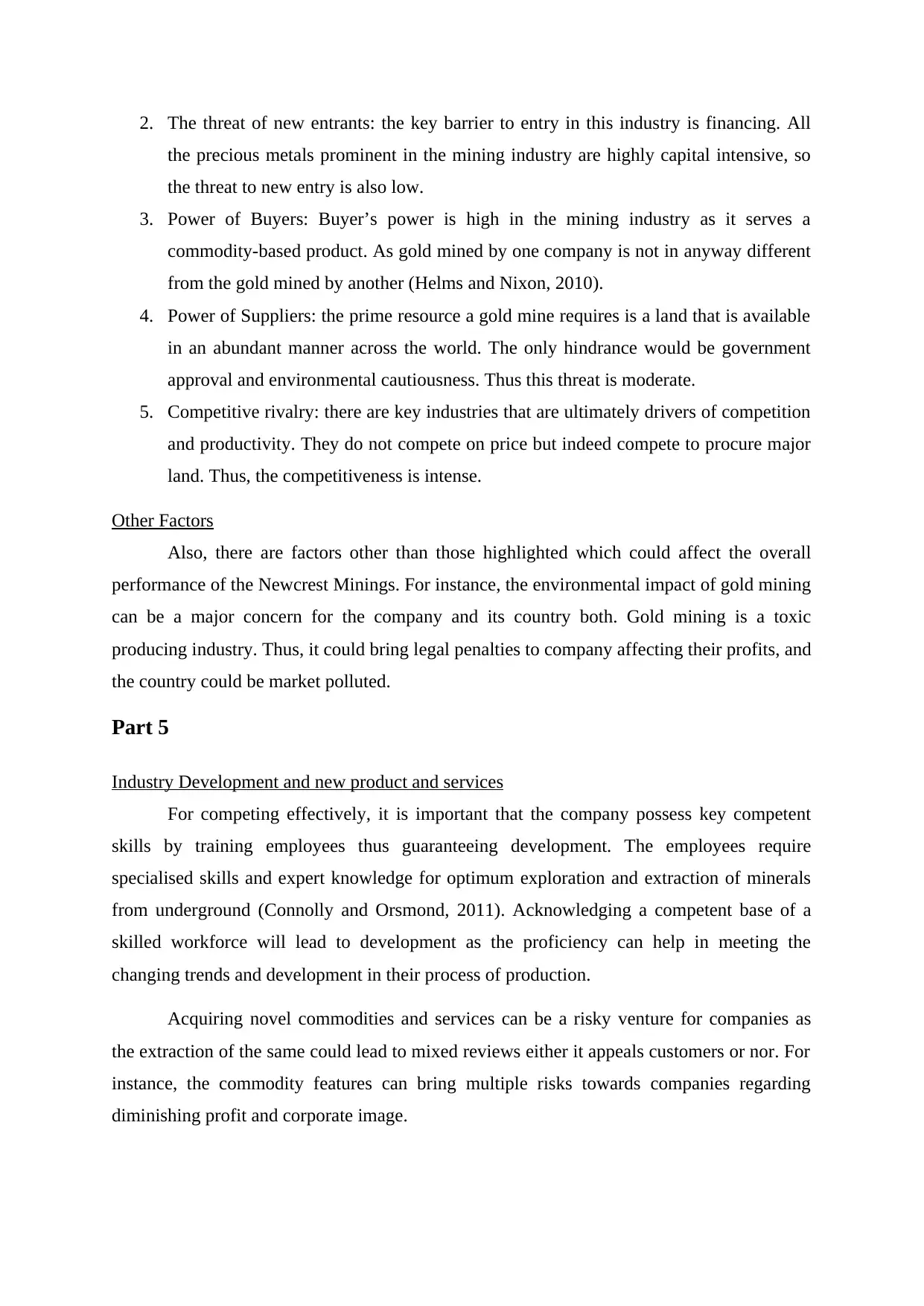
2. The threat of new entrants: the key barrier to entry in this industry is financing. All
the precious metals prominent in the mining industry are highly capital intensive, so
the threat to new entry is also low.
3. Power of Buyers: Buyer’s power is high in the mining industry as it serves a
commodity-based product. As gold mined by one company is not in anyway different
from the gold mined by another (Helms and Nixon, 2010).
4. Power of Suppliers: the prime resource a gold mine requires is a land that is available
in an abundant manner across the world. The only hindrance would be government
approval and environmental cautiousness. Thus this threat is moderate.
5. Competitive rivalry: there are key industries that are ultimately drivers of competition
and productivity. They do not compete on price but indeed compete to procure major
land. Thus, the competitiveness is intense.
Other Factors
Also, there are factors other than those highlighted which could affect the overall
performance of the Newcrest Minings. For instance, the environmental impact of gold mining
can be a major concern for the company and its country both. Gold mining is a toxic
producing industry. Thus, it could bring legal penalties to company affecting their profits, and
the country could be market polluted.
Part 5
Industry Development and new product and services
For competing effectively, it is important that the company possess key competent
skills by training employees thus guaranteeing development. The employees require
specialised skills and expert knowledge for optimum exploration and extraction of minerals
from underground (Connolly and Orsmond, 2011). Acknowledging a competent base of a
skilled workforce will lead to development as the proficiency can help in meeting the
changing trends and development in their process of production.
Acquiring novel commodities and services can be a risky venture for companies as
the extraction of the same could lead to mixed reviews either it appeals customers or nor. For
instance, the commodity features can bring multiple risks towards companies regarding
diminishing profit and corporate image.
the precious metals prominent in the mining industry are highly capital intensive, so
the threat to new entry is also low.
3. Power of Buyers: Buyer’s power is high in the mining industry as it serves a
commodity-based product. As gold mined by one company is not in anyway different
from the gold mined by another (Helms and Nixon, 2010).
4. Power of Suppliers: the prime resource a gold mine requires is a land that is available
in an abundant manner across the world. The only hindrance would be government
approval and environmental cautiousness. Thus this threat is moderate.
5. Competitive rivalry: there are key industries that are ultimately drivers of competition
and productivity. They do not compete on price but indeed compete to procure major
land. Thus, the competitiveness is intense.
Other Factors
Also, there are factors other than those highlighted which could affect the overall
performance of the Newcrest Minings. For instance, the environmental impact of gold mining
can be a major concern for the company and its country both. Gold mining is a toxic
producing industry. Thus, it could bring legal penalties to company affecting their profits, and
the country could be market polluted.
Part 5
Industry Development and new product and services
For competing effectively, it is important that the company possess key competent
skills by training employees thus guaranteeing development. The employees require
specialised skills and expert knowledge for optimum exploration and extraction of minerals
from underground (Connolly and Orsmond, 2011). Acknowledging a competent base of a
skilled workforce will lead to development as the proficiency can help in meeting the
changing trends and development in their process of production.
Acquiring novel commodities and services can be a risky venture for companies as
the extraction of the same could lead to mixed reviews either it appeals customers or nor. For
instance, the commodity features can bring multiple risks towards companies regarding
diminishing profit and corporate image.
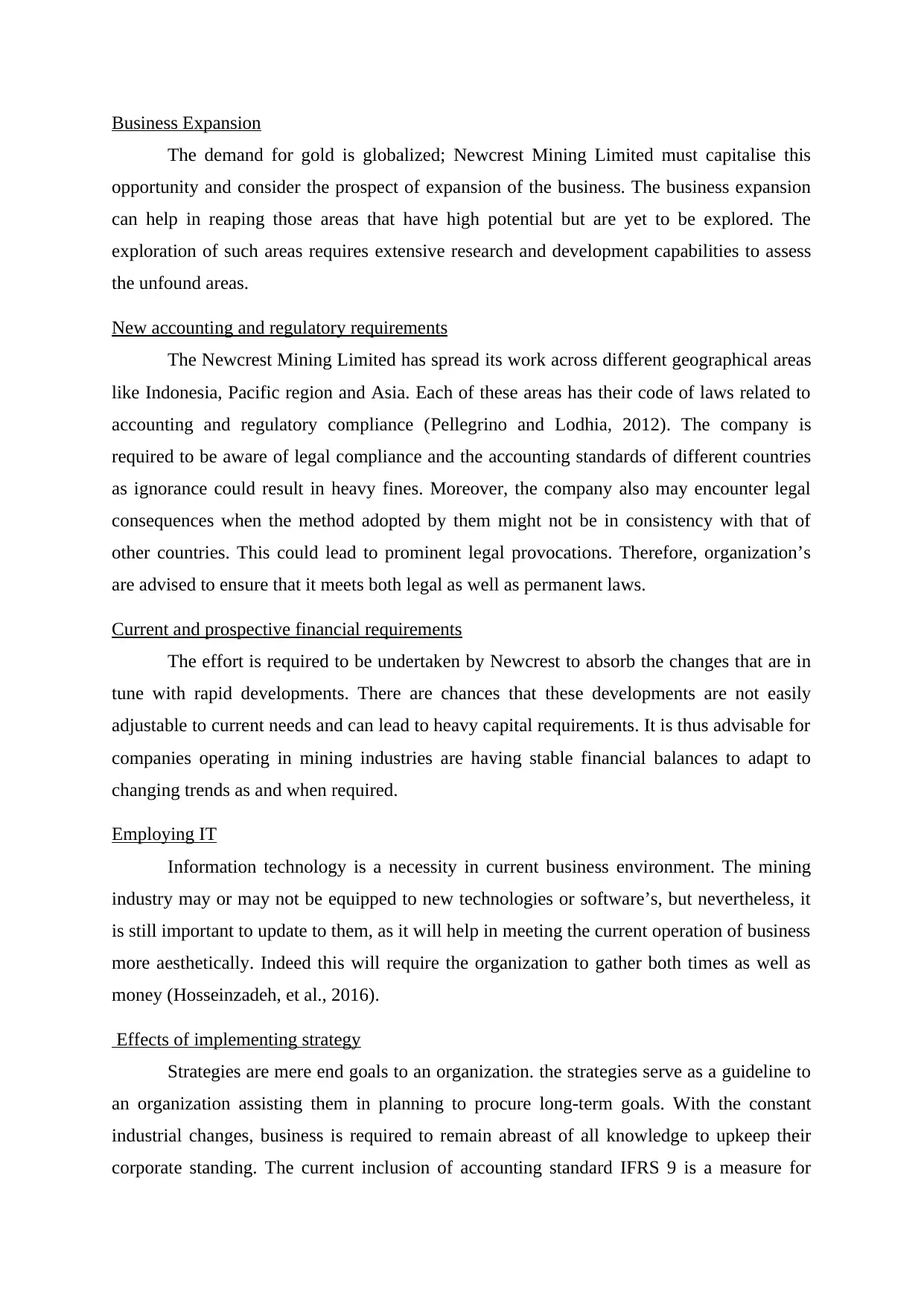
Business Expansion
The demand for gold is globalized; Newcrest Mining Limited must capitalise this
opportunity and consider the prospect of expansion of the business. The business expansion
can help in reaping those areas that have high potential but are yet to be explored. The
exploration of such areas requires extensive research and development capabilities to assess
the unfound areas.
New accounting and regulatory requirements
The Newcrest Mining Limited has spread its work across different geographical areas
like Indonesia, Pacific region and Asia. Each of these areas has their code of laws related to
accounting and regulatory compliance (Pellegrino and Lodhia, 2012). The company is
required to be aware of legal compliance and the accounting standards of different countries
as ignorance could result in heavy fines. Moreover, the company also may encounter legal
consequences when the method adopted by them might not be in consistency with that of
other countries. This could lead to prominent legal provocations. Therefore, organization’s
are advised to ensure that it meets both legal as well as permanent laws.
Current and prospective financial requirements
The effort is required to be undertaken by Newcrest to absorb the changes that are in
tune with rapid developments. There are chances that these developments are not easily
adjustable to current needs and can lead to heavy capital requirements. It is thus advisable for
companies operating in mining industries are having stable financial balances to adapt to
changing trends as and when required.
Employing IT
Information technology is a necessity in current business environment. The mining
industry may or may not be equipped to new technologies or software’s, but nevertheless, it
is still important to update to them, as it will help in meeting the current operation of business
more aesthetically. Indeed this will require the organization to gather both times as well as
money (Hosseinzadeh, et al., 2016).
Effects of implementing strategy
Strategies are mere end goals to an organization. the strategies serve as a guideline to
an organization assisting them in planning to procure long-term goals. With the constant
industrial changes, business is required to remain abreast of all knowledge to upkeep their
corporate standing. The current inclusion of accounting standard IFRS 9 is a measure for
The demand for gold is globalized; Newcrest Mining Limited must capitalise this
opportunity and consider the prospect of expansion of the business. The business expansion
can help in reaping those areas that have high potential but are yet to be explored. The
exploration of such areas requires extensive research and development capabilities to assess
the unfound areas.
New accounting and regulatory requirements
The Newcrest Mining Limited has spread its work across different geographical areas
like Indonesia, Pacific region and Asia. Each of these areas has their code of laws related to
accounting and regulatory compliance (Pellegrino and Lodhia, 2012). The company is
required to be aware of legal compliance and the accounting standards of different countries
as ignorance could result in heavy fines. Moreover, the company also may encounter legal
consequences when the method adopted by them might not be in consistency with that of
other countries. This could lead to prominent legal provocations. Therefore, organization’s
are advised to ensure that it meets both legal as well as permanent laws.
Current and prospective financial requirements
The effort is required to be undertaken by Newcrest to absorb the changes that are in
tune with rapid developments. There are chances that these developments are not easily
adjustable to current needs and can lead to heavy capital requirements. It is thus advisable for
companies operating in mining industries are having stable financial balances to adapt to
changing trends as and when required.
Employing IT
Information technology is a necessity in current business environment. The mining
industry may or may not be equipped to new technologies or software’s, but nevertheless, it
is still important to update to them, as it will help in meeting the current operation of business
more aesthetically. Indeed this will require the organization to gather both times as well as
money (Hosseinzadeh, et al., 2016).
Effects of implementing strategy
Strategies are mere end goals to an organization. the strategies serve as a guideline to
an organization assisting them in planning to procure long-term goals. With the constant
industrial changes, business is required to remain abreast of all knowledge to upkeep their
corporate standing. The current inclusion of accounting standard IFRS 9 is a measure for
Secure Best Marks with AI Grader
Need help grading? Try our AI Grader for instant feedback on your assignments.
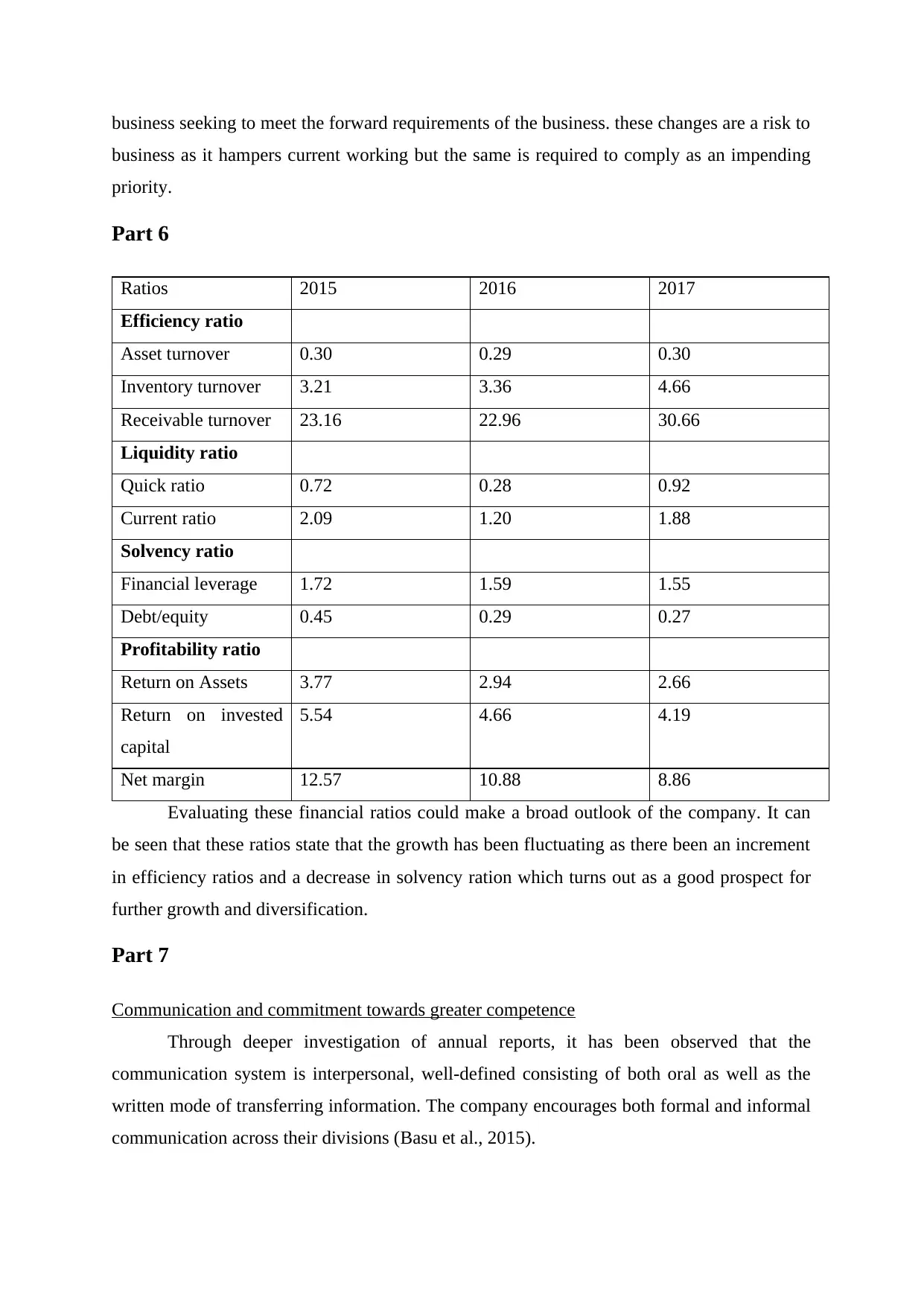
business seeking to meet the forward requirements of the business. these changes are a risk to
business as it hampers current working but the same is required to comply as an impending
priority.
Part 6
Ratios 2015 2016 2017
Efficiency ratio
Asset turnover 0.30 0.29 0.30
Inventory turnover 3.21 3.36 4.66
Receivable turnover 23.16 22.96 30.66
Liquidity ratio
Quick ratio 0.72 0.28 0.92
Current ratio 2.09 1.20 1.88
Solvency ratio
Financial leverage 1.72 1.59 1.55
Debt/equity 0.45 0.29 0.27
Profitability ratio
Return on Assets 3.77 2.94 2.66
Return on invested
capital
5.54 4.66 4.19
Net margin 12.57 10.88 8.86
Evaluating these financial ratios could make a broad outlook of the company. It can
be seen that these ratios state that the growth has been fluctuating as there been an increment
in efficiency ratios and a decrease in solvency ration which turns out as a good prospect for
further growth and diversification.
Part 7
Communication and commitment towards greater competence
Through deeper investigation of annual reports, it has been observed that the
communication system is interpersonal, well-defined consisting of both oral as well as the
written mode of transferring information. The company encourages both formal and informal
communication across their divisions (Basu et al., 2015).
business as it hampers current working but the same is required to comply as an impending
priority.
Part 6
Ratios 2015 2016 2017
Efficiency ratio
Asset turnover 0.30 0.29 0.30
Inventory turnover 3.21 3.36 4.66
Receivable turnover 23.16 22.96 30.66
Liquidity ratio
Quick ratio 0.72 0.28 0.92
Current ratio 2.09 1.20 1.88
Solvency ratio
Financial leverage 1.72 1.59 1.55
Debt/equity 0.45 0.29 0.27
Profitability ratio
Return on Assets 3.77 2.94 2.66
Return on invested
capital
5.54 4.66 4.19
Net margin 12.57 10.88 8.86
Evaluating these financial ratios could make a broad outlook of the company. It can
be seen that these ratios state that the growth has been fluctuating as there been an increment
in efficiency ratios and a decrease in solvency ration which turns out as a good prospect for
further growth and diversification.
Part 7
Communication and commitment towards greater competence
Through deeper investigation of annual reports, it has been observed that the
communication system is interpersonal, well-defined consisting of both oral as well as the
written mode of transferring information. The company encourages both formal and informal
communication across their divisions (Basu et al., 2015).
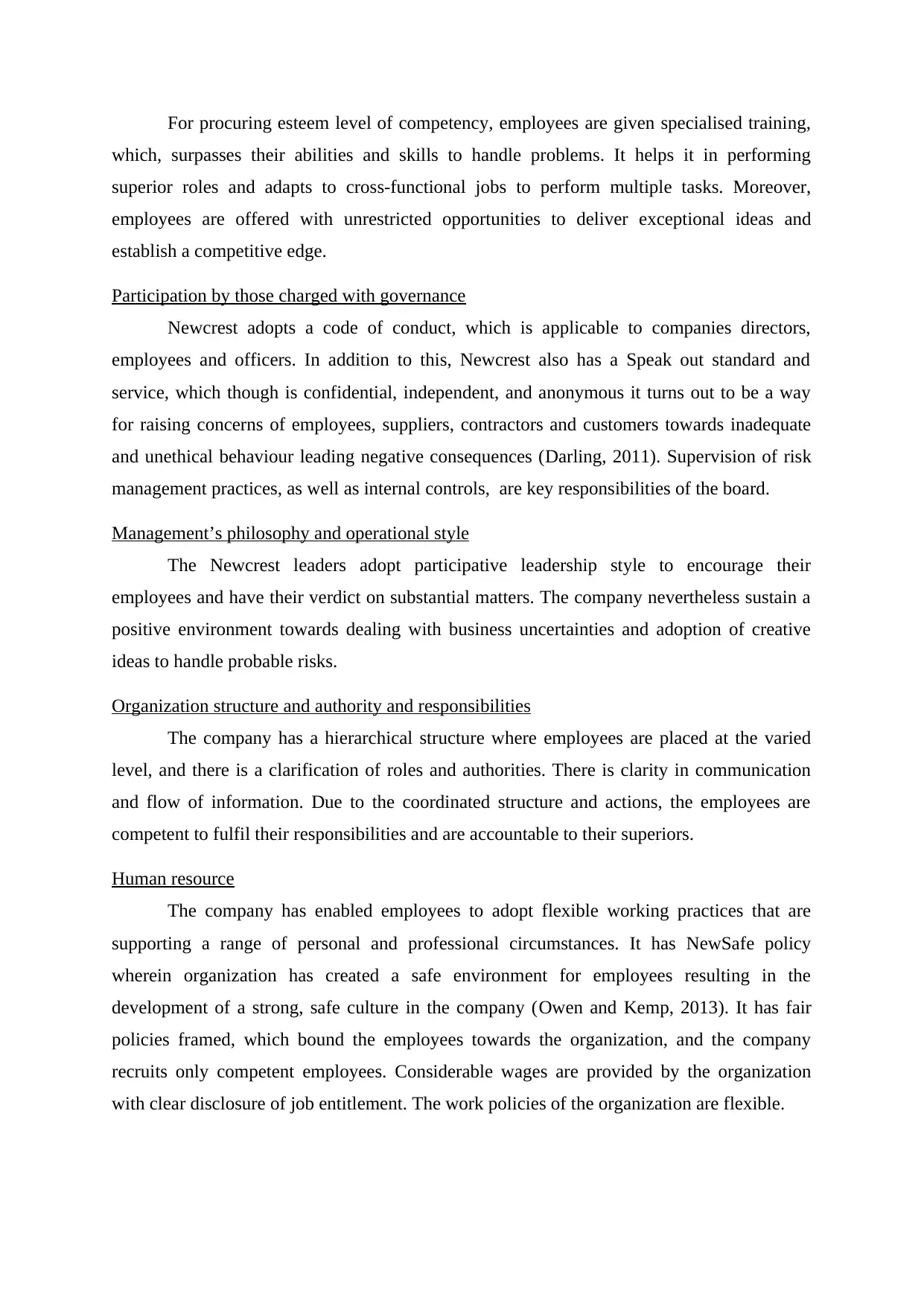
For procuring esteem level of competency, employees are given specialised training,
which, surpasses their abilities and skills to handle problems. It helps it in performing
superior roles and adapts to cross-functional jobs to perform multiple tasks. Moreover,
employees are offered with unrestricted opportunities to deliver exceptional ideas and
establish a competitive edge.
Participation by those charged with governance
Newcrest adopts a code of conduct, which is applicable to companies directors,
employees and officers. In addition to this, Newcrest also has a Speak out standard and
service, which though is confidential, independent, and anonymous it turns out to be a way
for raising concerns of employees, suppliers, contractors and customers towards inadequate
and unethical behaviour leading negative consequences (Darling, 2011). Supervision of risk
management practices, as well as internal controls, are key responsibilities of the board.
Management’s philosophy and operational style
The Newcrest leaders adopt participative leadership style to encourage their
employees and have their verdict on substantial matters. The company nevertheless sustain a
positive environment towards dealing with business uncertainties and adoption of creative
ideas to handle probable risks.
Organization structure and authority and responsibilities
The company has a hierarchical structure where employees are placed at the varied
level, and there is a clarification of roles and authorities. There is clarity in communication
and flow of information. Due to the coordinated structure and actions, the employees are
competent to fulfil their responsibilities and are accountable to their superiors.
Human resource
The company has enabled employees to adopt flexible working practices that are
supporting a range of personal and professional circumstances. It has NewSafe policy
wherein organization has created a safe environment for employees resulting in the
development of a strong, safe culture in the company (Owen and Kemp, 2013). It has fair
policies framed, which bound the employees towards the organization, and the company
recruits only competent employees. Considerable wages are provided by the organization
with clear disclosure of job entitlement. The work policies of the organization are flexible.
which, surpasses their abilities and skills to handle problems. It helps it in performing
superior roles and adapts to cross-functional jobs to perform multiple tasks. Moreover,
employees are offered with unrestricted opportunities to deliver exceptional ideas and
establish a competitive edge.
Participation by those charged with governance
Newcrest adopts a code of conduct, which is applicable to companies directors,
employees and officers. In addition to this, Newcrest also has a Speak out standard and
service, which though is confidential, independent, and anonymous it turns out to be a way
for raising concerns of employees, suppliers, contractors and customers towards inadequate
and unethical behaviour leading negative consequences (Darling, 2011). Supervision of risk
management practices, as well as internal controls, are key responsibilities of the board.
Management’s philosophy and operational style
The Newcrest leaders adopt participative leadership style to encourage their
employees and have their verdict on substantial matters. The company nevertheless sustain a
positive environment towards dealing with business uncertainties and adoption of creative
ideas to handle probable risks.
Organization structure and authority and responsibilities
The company has a hierarchical structure where employees are placed at the varied
level, and there is a clarification of roles and authorities. There is clarity in communication
and flow of information. Due to the coordinated structure and actions, the employees are
competent to fulfil their responsibilities and are accountable to their superiors.
Human resource
The company has enabled employees to adopt flexible working practices that are
supporting a range of personal and professional circumstances. It has NewSafe policy
wherein organization has created a safe environment for employees resulting in the
development of a strong, safe culture in the company (Owen and Kemp, 2013). It has fair
policies framed, which bound the employees towards the organization, and the company
recruits only competent employees. Considerable wages are provided by the organization
with clear disclosure of job entitlement. The work policies of the organization are flexible.
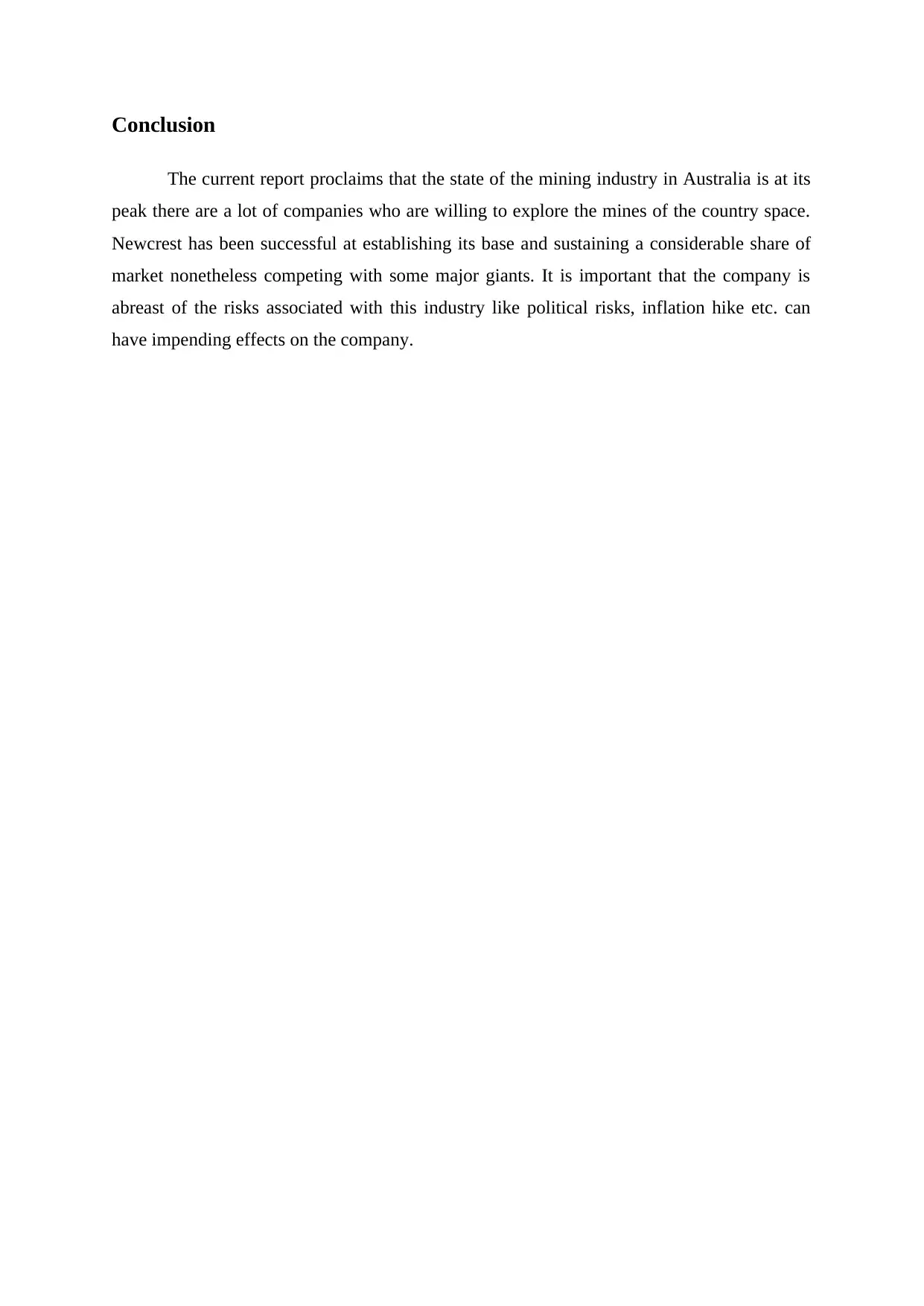
Conclusion
The current report proclaims that the state of the mining industry in Australia is at its
peak there are a lot of companies who are willing to explore the mines of the country space.
Newcrest has been successful at establishing its base and sustaining a considerable share of
market nonetheless competing with some major giants. It is important that the company is
abreast of the risks associated with this industry like political risks, inflation hike etc. can
have impending effects on the company.
The current report proclaims that the state of the mining industry in Australia is at its
peak there are a lot of companies who are willing to explore the mines of the country space.
Newcrest has been successful at establishing its base and sustaining a considerable share of
market nonetheless competing with some major giants. It is important that the company is
abreast of the risks associated with this industry like political risks, inflation hike etc. can
have impending effects on the company.
Paraphrase This Document
Need a fresh take? Get an instant paraphrase of this document with our AI Paraphraser
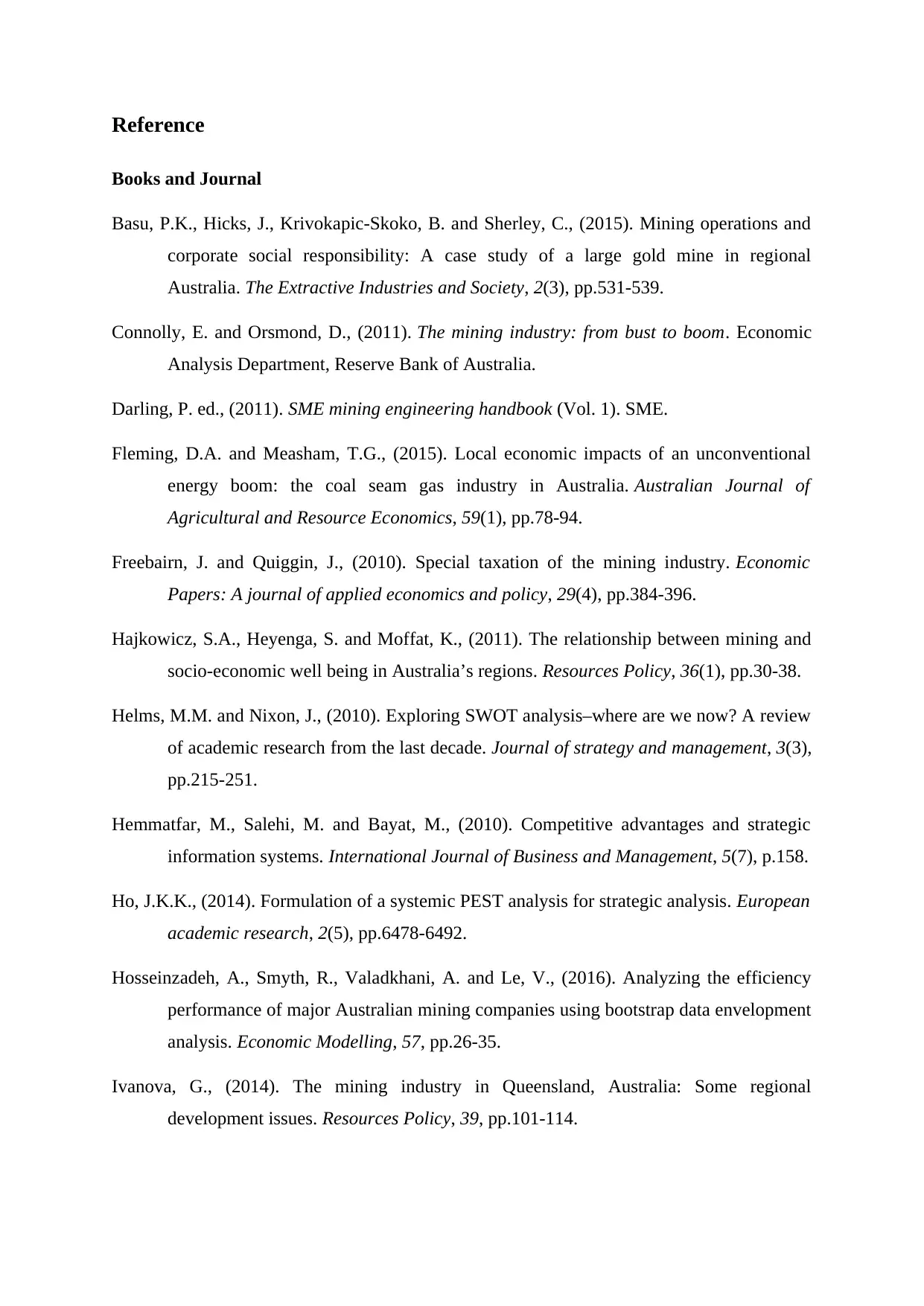
Reference
Books and Journal
Basu, P.K., Hicks, J., Krivokapic-Skoko, B. and Sherley, C., (2015). Mining operations and
corporate social responsibility: A case study of a large gold mine in regional
Australia. The Extractive Industries and Society, 2(3), pp.531-539.
Connolly, E. and Orsmond, D., (2011). The mining industry: from bust to boom. Economic
Analysis Department, Reserve Bank of Australia.
Darling, P. ed., (2011). SME mining engineering handbook (Vol. 1). SME.
Fleming, D.A. and Measham, T.G., (2015). Local economic impacts of an unconventional
energy boom: the coal seam gas industry in Australia. Australian Journal of
Agricultural and Resource Economics, 59(1), pp.78-94.
Freebairn, J. and Quiggin, J., (2010). Special taxation of the mining industry. Economic
Papers: A journal of applied economics and policy, 29(4), pp.384-396.
Hajkowicz, S.A., Heyenga, S. and Moffat, K., (2011). The relationship between mining and
socio-economic well being in Australia’s regions. Resources Policy, 36(1), pp.30-38.
Helms, M.M. and Nixon, J., (2010). Exploring SWOT analysis–where are we now? A review
of academic research from the last decade. Journal of strategy and management, 3(3),
pp.215-251.
Hemmatfar, M., Salehi, M. and Bayat, M., (2010). Competitive advantages and strategic
information systems. International Journal of Business and Management, 5(7), p.158.
Ho, J.K.K., (2014). Formulation of a systemic PEST analysis for strategic analysis. European
academic research, 2(5), pp.6478-6492.
Hosseinzadeh, A., Smyth, R., Valadkhani, A. and Le, V., (2016). Analyzing the efficiency
performance of major Australian mining companies using bootstrap data envelopment
analysis. Economic Modelling, 57, pp.26-35.
Ivanova, G., (2014). The mining industry in Queensland, Australia: Some regional
development issues. Resources Policy, 39, pp.101-114.
Books and Journal
Basu, P.K., Hicks, J., Krivokapic-Skoko, B. and Sherley, C., (2015). Mining operations and
corporate social responsibility: A case study of a large gold mine in regional
Australia. The Extractive Industries and Society, 2(3), pp.531-539.
Connolly, E. and Orsmond, D., (2011). The mining industry: from bust to boom. Economic
Analysis Department, Reserve Bank of Australia.
Darling, P. ed., (2011). SME mining engineering handbook (Vol. 1). SME.
Fleming, D.A. and Measham, T.G., (2015). Local economic impacts of an unconventional
energy boom: the coal seam gas industry in Australia. Australian Journal of
Agricultural and Resource Economics, 59(1), pp.78-94.
Freebairn, J. and Quiggin, J., (2010). Special taxation of the mining industry. Economic
Papers: A journal of applied economics and policy, 29(4), pp.384-396.
Hajkowicz, S.A., Heyenga, S. and Moffat, K., (2011). The relationship between mining and
socio-economic well being in Australia’s regions. Resources Policy, 36(1), pp.30-38.
Helms, M.M. and Nixon, J., (2010). Exploring SWOT analysis–where are we now? A review
of academic research from the last decade. Journal of strategy and management, 3(3),
pp.215-251.
Hemmatfar, M., Salehi, M. and Bayat, M., (2010). Competitive advantages and strategic
information systems. International Journal of Business and Management, 5(7), p.158.
Ho, J.K.K., (2014). Formulation of a systemic PEST analysis for strategic analysis. European
academic research, 2(5), pp.6478-6492.
Hosseinzadeh, A., Smyth, R., Valadkhani, A. and Le, V., (2016). Analyzing the efficiency
performance of major Australian mining companies using bootstrap data envelopment
analysis. Economic Modelling, 57, pp.26-35.
Ivanova, G., (2014). The mining industry in Queensland, Australia: Some regional
development issues. Resources Policy, 39, pp.101-114.
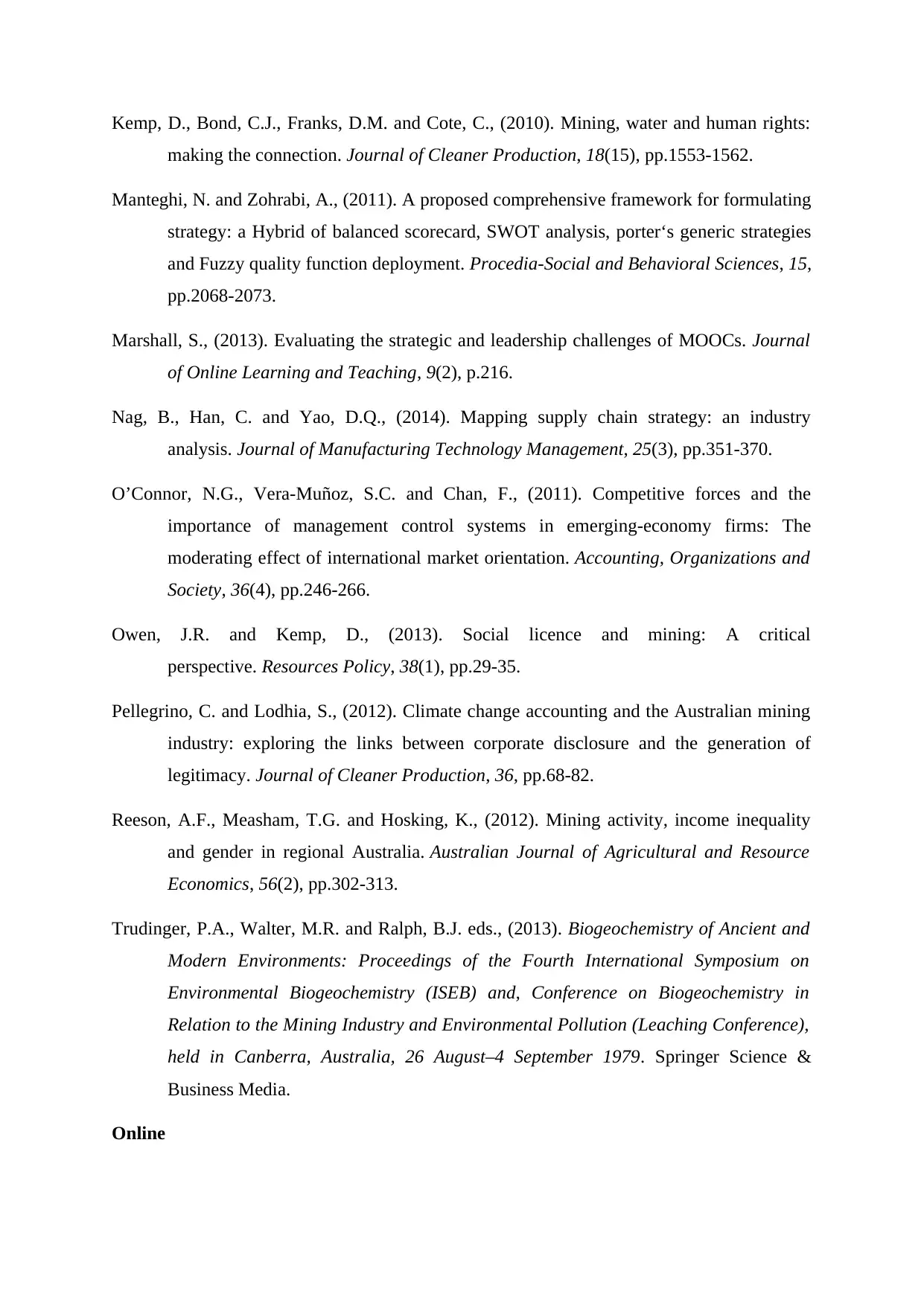
Kemp, D., Bond, C.J., Franks, D.M. and Cote, C., (2010). Mining, water and human rights:
making the connection. Journal of Cleaner Production, 18(15), pp.1553-1562.
Manteghi, N. and Zohrabi, A., (2011). A proposed comprehensive framework for formulating
strategy: a Hybrid of balanced scorecard, SWOT analysis, porter‘s generic strategies
and Fuzzy quality function deployment. Procedia-Social and Behavioral Sciences, 15,
pp.2068-2073.
Marshall, S., (2013). Evaluating the strategic and leadership challenges of MOOCs. Journal
of Online Learning and Teaching, 9(2), p.216.
Nag, B., Han, C. and Yao, D.Q., (2014). Mapping supply chain strategy: an industry
analysis. Journal of Manufacturing Technology Management, 25(3), pp.351-370.
O’Connor, N.G., Vera-Muñoz, S.C. and Chan, F., (2011). Competitive forces and the
importance of management control systems in emerging-economy firms: The
moderating effect of international market orientation. Accounting, Organizations and
Society, 36(4), pp.246-266.
Owen, J.R. and Kemp, D., (2013). Social licence and mining: A critical
perspective. Resources Policy, 38(1), pp.29-35.
Pellegrino, C. and Lodhia, S., (2012). Climate change accounting and the Australian mining
industry: exploring the links between corporate disclosure and the generation of
legitimacy. Journal of Cleaner Production, 36, pp.68-82.
Reeson, A.F., Measham, T.G. and Hosking, K., (2012). Mining activity, income inequality
and gender in regional Australia. Australian Journal of Agricultural and Resource
Economics, 56(2), pp.302-313.
Trudinger, P.A., Walter, M.R. and Ralph, B.J. eds., (2013). Biogeochemistry of Ancient and
Modern Environments: Proceedings of the Fourth International Symposium on
Environmental Biogeochemistry (ISEB) and, Conference on Biogeochemistry in
Relation to the Mining Industry and Environmental Pollution (Leaching Conference),
held in Canberra, Australia, 26 August–4 September 1979. Springer Science &
Business Media.
Online
making the connection. Journal of Cleaner Production, 18(15), pp.1553-1562.
Manteghi, N. and Zohrabi, A., (2011). A proposed comprehensive framework for formulating
strategy: a Hybrid of balanced scorecard, SWOT analysis, porter‘s generic strategies
and Fuzzy quality function deployment. Procedia-Social and Behavioral Sciences, 15,
pp.2068-2073.
Marshall, S., (2013). Evaluating the strategic and leadership challenges of MOOCs. Journal
of Online Learning and Teaching, 9(2), p.216.
Nag, B., Han, C. and Yao, D.Q., (2014). Mapping supply chain strategy: an industry
analysis. Journal of Manufacturing Technology Management, 25(3), pp.351-370.
O’Connor, N.G., Vera-Muñoz, S.C. and Chan, F., (2011). Competitive forces and the
importance of management control systems in emerging-economy firms: The
moderating effect of international market orientation. Accounting, Organizations and
Society, 36(4), pp.246-266.
Owen, J.R. and Kemp, D., (2013). Social licence and mining: A critical
perspective. Resources Policy, 38(1), pp.29-35.
Pellegrino, C. and Lodhia, S., (2012). Climate change accounting and the Australian mining
industry: exploring the links between corporate disclosure and the generation of
legitimacy. Journal of Cleaner Production, 36, pp.68-82.
Reeson, A.F., Measham, T.G. and Hosking, K., (2012). Mining activity, income inequality
and gender in regional Australia. Australian Journal of Agricultural and Resource
Economics, 56(2), pp.302-313.
Trudinger, P.A., Walter, M.R. and Ralph, B.J. eds., (2013). Biogeochemistry of Ancient and
Modern Environments: Proceedings of the Fourth International Symposium on
Environmental Biogeochemistry (ISEB) and, Conference on Biogeochemistry in
Relation to the Mining Industry and Environmental Pollution (Leaching Conference),
held in Canberra, Australia, 26 August–4 September 1979. Springer Science &
Business Media.
Online
1 out of 21
Related Documents
Your All-in-One AI-Powered Toolkit for Academic Success.
+13062052269
info@desklib.com
Available 24*7 on WhatsApp / Email
![[object Object]](/_next/static/media/star-bottom.7253800d.svg)
Unlock your academic potential
© 2024 | Zucol Services PVT LTD | All rights reserved.




